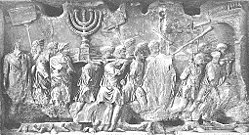ňç▒ŠŚőň╝Ć  ŃâşŃâ╝Ńâ×Ńü«ňç▒ŠŚőň╝Ć´╝łŃüîŃüäŃüŤŃéôŃüŚŃüŹŃÇütriumphus´╝ëŃü»ŃÇüňĆĄń╗úŃâşŃâ╝Ńâ×ŃüźŃüŐŃüĹŃéőňŞéŠ░ĹňäÇň╝ĆŃÇüŃüŐŃéłŃü│ň«ŚŠĽÖšÜäňůŞšĄ╝ŃüžŃüéŃéŐŃÇüňŤŻň«ÂŃü«ňőŁňłęŃüźŔ▓óšî«ŃüŚŃüčňĆŞń╗Ąň«śŃéĺŠ░ĹŔíćŃü«ňëŹŃüžŔ«âŃüłŃéőŃéĄŃâÖŃâ│ŃâłŃüžŃüéŃéőŃÇé ňç▒ŠŚőň╝ĆŃü«ŠŚąŃÇüň░ćŔ╗ŹŃü»ŃâČŃéČŃâ¬Ńéó´╝łšÄőńŻŹŃü«Ŕ▒íňż┤´╝ëŃüĘŃüŚŃüŽŠťłŠíéŠĘ╣Ńü«ňćáŃéĺŃüőŃüÂŃéŐŃÇüÚçĹš│ŞŃüžňł║š╣ŹŃüŚŃüčš┤źŔë▓Ńü«ŃâłŃéČŃé嚣ǚöĘŃüŚŃüčŃÇéŃüôŃéîŃü»ŃüŁŃü«ň░ćŔ╗ŹŃüîŃÇüňŹŐŃü░šą×ŔüľŃüžŃÇüňÉŤńŞ╗ŃüźŔ┐ĹŃüäňşśňťĘŃüĘŔ¬ŹŃéüŃéëŃéîŃüŽŃüäŃüčŃüčŃéüŃüžŃüéŃéŐŃÇüŃüŁŃü«ÚíöŃéĺ´╝łšą×ŃüžŃüéŃéőŃüôŃüĘŃé嚥║ŃüÖ´╝ëŔÁĄŃüĆňíŚŃéőŃüôŃüĘŃééščąŃéëŃéîŃüŽŃüäŃéőŃÇéňç▒ŠŚőň░ćŔ╗ŹŃü»4ÚáşšźőŃüŽŃü«ŠłŽŔ╗ŐŃüźń╣ŚŃéŐŃÇüڣ׊şŽŔúůŃü«ňůÁňúźŃÇüŠŹĽŔÖťŃÇüŠłŽňłęňôüŃéĺňżôŃüłŃüŽŃâşŃâ╝Ńâ×ňŞéňćůŃéĺŔíîÚÇ▓ŃüŚŃüčŃÇ銝ÇňżîŃüźŃéźŃâöŃâłŃâ¬ŃâîŃé╣Ńü«ńŞśŃü«ŃâŽŃâöŃâćŃâźŃâ╗Ńé¬ŃâŚŃâćŃéúŃâáŃé╣Ńâ╗Ńâ×ŃéşŃéĚŃâáŃé╣ŃÇüŃâŽŃâ╝ŃâÄŃâ╝ŃÇüŃâčŃâŹŃâźŃéŽŃé횹׊«┐ŃüžŃÇüšą×ŃÇůŃüźň»żŃüŚŃüŽšŐášë▓ŃüĘňőŁňłęŃü«ŔĘ╝ŠőáŃé劏žŃüĺŃüčŃÇéňů▒ňĺîŠö┐ŃâşŃâ╝Ńâ׊Öéń╗úŃü«ŃÇšąľŃü«Úü║ÚóĘŃÇŹ´╝łŃâóŃé╣Ńâ╗Ńâ×ŃéĄŃé¬ŃâźŃâá´╝ëŃüźňżôŃüäŃÇüŃüôŃü«ŃéłŃüćŃü¬šë╣ňłąŃü¬ŠÖéÚľôŃüžŃüéŃéőŃüźŃééŃüőŃüőŃéĆŃéëŃüÜŃÇüň░ćŔ╗ŹŃü»ŃâşŃâ╝Ńâ×ňůâŔÇüÚÖóŃÇüňŞéŠ░ĹŃÇüšą×ŃÇůŃü«ń╗úšÉćŃüĘŃüŚŃüŽŃÇüňĘüňÄ│ŃéĺŠîüŃüíŃüőŃüĄŔČÖŔÖÜŃüźŠî»Ŕł×ŃüúŃüčŃÇéňÉîŠÖéŃüźŃÇüňç▒ŠŚőň╝ĆŃü»ň«ŚŠĽÖšÜäŃüŐŃéłŃü│Ŕ╗Źń║őšÜäňäÇň╝ĆŃüĘŃüŚŃüŽŃüáŃüĹŃüžŃü¬ŃüĆŃÇüŔç¬ňĚ▒ň«úń╝ŁŃü«ŃüčŃéüŃü«šë╣ňłąŃü¬Šęčń╝ÜŃéĺŠĆÉńżŤŃüŚŃüčŃÇé Ńü╗ŃüĘŃéôŃüęŃü«ŃâşŃâ╝Ńâ×Ńü«šąşŠŚąŃü»ŠÜŽŃüžŠ▒║ŃüżŃüúŃüŽŃüäŃüčŃüîŃÇüňç▒ŠŚőň╝ĆŃéĺŔíîŃü抌ąŃü»Ŕ笚ö▒ŃüžŃüéŃéŐŃÇüňőŁňłęŃüőŃéëŃüžŃüŹŃéőŃüáŃüĹŠŚęŃüĆň«čŠľŻŃüĽŃéîŃüčŃÇéŃâĹŃâČŃâ╝ŃâëŃü«Ńü╗ŃüőŃüźšąŁň«┤ŃÇüšźÂŠŐÇń╝ÜŃü¬ŃüęŃééÚľőňéČŃüĽŃéîŃüčŃÇéňů▒ňĺîŠö┐ňżîŠťčŃüźŃü¬ŃéőŃüĘŃÇüŃâşŃâ╝Ńâ×Ńü«Šőíň╝ÁŃüźŃüŚŃüčŃüîŃüúŃüŽňÉäň░ćŔ╗ŹŃüîšźÂŃüäňÉłŃüćŃéłŃüćŃüźŃü¬ŃéŐŃÇüňç▒ŠŚőň╝ĆŃü»ÚĽĚŠťčÚľôŃüőŃüĄŔ▒¬ŔĆ»ŃüźŃü¬ŃéŐŃÇüŠĽ░ŠŚąÚľôŃüźŃéĆŃüčŃéŐňůČňů▒Ńü«šźÂŠŐÇń╝ÜŃéäšąşŃéŐŃüîšÂÜŃüĆŃüôŃüĘŃééŃüéŃüúŃüčŃÇéňŞŁŠö┐ŃüîňžőŃüżŃéőŃüĘŃÇüňç▒ŠŚőň╝ĆŃü»ňŞŁňŤŻŃü«šžęň║ĆŃéĺňĆŹŠśáŃüŚŃÇüšÜçňŞŁň«ÂŠŚĆŃü«Ńü┐Ńüîň«čŠľŻŃüžŃüŹŃéőŃééŃü«ŃüĘŃü¬ŃüúŃüč´╝łń╗ľŃü«ň░ćŔ╗ŹŃü»ňç▒ŠŚőň░ćŔ╗ŹÚíĽňŻ░ŃéĺŠÄłńŞÄŃüĽŃéîŃéőŃü«Ńü┐´╝ëŃÇé ňç▒ŠŚőň╝ĆŃü«Šžśň╝ĆŃü»ŃÇüńŞşńŞľń╗ąÚÖŹŃüźŃâĘŃâ╝ŃâşŃââŃâĹŃü«šÄőŠŚĆŃüîšťčń╝╝ŃéőŃéłŃüćŃüźŃü¬ŃüúŃüčŃÇé ŔâîŠÖ»ŃüĘňäÇň╝Ćňç▒ŠŚőň░ćŔ╗Źňů▒ňĺîŠö┐ŃâşŃâ╝Ńâ×ŃüźŃüŐŃüäŃüŽŃü»ŃÇüšťčŃüźńżőňĄľšÜäŃü¬ňőŁňłęŃüźň»żŃüŚŃüŽŠťÇÚźśŃü«ŠáäŔ¬ëŃüîńŞÄŃüłŃéëŃéîŃÇüŃÇîňç▒ŠŚőň░ćŔ╗ŹŃÇŹ´╝łvir triumphalis´╝ëŃüĘŃüŚŃüŽňŹŐŃü░ń╝ŁŔ¬ČšÜäŃü¬ń║║šëęŃüĘŃü┐Ńü¬ŃüĽŃéîŃüčŃÇéň«čÚÜŤŃÇüň░ćŔ╗ŹŃü»ŃÇîŃüŁŃü«ŠŚąŃü«šÄőŃÇŹŃüžŃüéŃéŐŃÇüňŹŐŃü░šą×ŔüľŃü¬ŃééŃü«ŃüĘŃüĽŃéîŃüčŃÇéňŻ╝Ńü»šÄőŠö┐ŃâşŃâ╝Ńâ×Ńü«ń╝ŁšÁ▒šÜäŃü¬šÄőńŻŹŃü«Ŕ▒íňż┤ŃüžŃüéŃéőÚçĹŃüžňł║š╣ŹŃüŚŃüčš┤źŔë▓Ńü«ŃâłŃéČŃÇüŠťłŠíéŠĘ╣Ńü«ňćáŃÇüŔÁĄŃüäŃâľŃâ╝ŃâäŃé嚣ǚöĘŃüŚŃÇüŃâşŃâ╝Ńâ×Ńü«ŠťÇÚźśšą×ŃâŽŃâöŃâćŃâźŃâ╗ŃéźŃâöŃâłŃâ¬ŃâîŃé╣ŃéĺŔíĘŃüÖŃüčŃéüŃüźÚíöŃéĺŔÁĄŃüĆňíŚŃüúŃüčŃÇé4ÚáşšźőŃüŽŃü«ŠłŽŔ╗ŐŃüźń╣ŚŃéŐŃÇüňÉîňâÜŃüĘŠőŹŠëőŃéĺÚÇüŃéőňĄžŔíćŃüîŔŽőň«łŃéőńŞşŃÇüŃâşŃâ╝Ńâ×Ńü«ŔíŚńŞşŃéĺŔíîÚÇ▓ŃüŚŃÇüŃéźŃâöŃâłŃâ¬ŃâîŃé╣Ńü«ńŞśŃü«ŃâŽŃâöŃâćŃâźšą×Š«┐ŃüŞŃüĘňÉĹŃüőŃüúŃüčŃÇ銏ĽŔÖťŃüĘŠłŽňłęňôüŃüîňůłŃüźÚÇ▓Ńü┐ŃÇüŃâşŃâ╝Ńâ×Ŕ╗ŹňůÁňúźŃü»ňżîŃüźšÂÜŃüäŃüčŃÇéŃéźŃâöŃâłŃâ¬ŃâîŃé╣Ńü«šą×Š«┐ŃüźšŁÇŃüĆŃüĘŃÇüŃâŽŃâöŃâćŃâźŃü«ŃüčŃéüŃüź2ÚáşŃü«ÚŤäšëŤŃéĺšöčŔ┤äŃüĘŃüŚŃÇüŃâŽŃâöŃâćŃâźňâĆŃü«ŔÂ│ňůâŃüźňőŁňłęŃü«ňŹ░Ńé嚯«ŃüŹŃÇüŃüŁŃü«ňőŁňłęŃéĺňůâŔÇüÚÖóŃÇüŃâşŃâ╝Ńâ×ňŞéŠ░ĹŃüŐŃéłŃü│ŃâşŃâ╝Ńâ×Ńü«šą×ŃÇůŃüźŠŹžŃüĺŃüč[1]ŃÇé ňç▒ŠŚőň╝ĆŃü«ň«čŠľŻŠŚąŃü»ŃÇüŃâşŃâ╝Ńâ×Ńü«ň«ŚŠĽÖšÜäňäÇň╝ĆŃÇüšąŁšąşŃüĘŃü»šäíÚľóń┐éŃüźŠ▒║ŃéüŃéëŃéîŃüčŃÇéŃü╗ŃüĘŃéôŃüęŃü«ňá┤ňÉłŃÇüň«čŔíîňĆ»ŔâŻŃü¬ŠťÇŃé銌ęŃüäň╣ŞňůłŃü«Ŕë»Ńü䊌ąŃüźň«čŠľŻŃüĽŃéîŃüŽŃüäŃéőŃéłŃüćŃüžŃüéŃéőŃÇéń╝ŁšÁ▒šÜäŃüźŃÇüŃâşŃâ╝Ńâ×Ńü«ňůĘŃüŽŃü«šą×Š«┐Ńüîňç▒ŠŚőň╝ĆŃü«ŠťčÚľôńŞşŃü»ÚľőŃüĹŃéëŃéîŃüŽŃüäŃüčŃÇéň╝ĆňůŞŃü»ŃÇüŃüéŃéőŠäĆňĹ│ŃüžŃü»ŃÇüŃâşŃâ╝Ńâ×Ńü«ňůĘŃüŽŃü«šą×ŃÇůŃüîňłćŃüőŃüíňÉłŃüćŃééŃü«ŃüžŃüéŃéőŃüî[2]ŃÇüšë╣ň«ÜŃü«šąŁšąşŃéäŔĘśň┐ÁŠŚąŃüźÚçŹŃü¬ŃéőŃüôŃüĘŃééÚü┐ŃüĹŃéëŃéîŃü¬ŃüőŃüúŃüčŃÇéŃüôŃéîŃéëŃü«ň╣żŃüĄŃüőŃü»ňüšäÂŃüőŃééŃüŚŃéîŃü¬ŃüäŃüîŃÇüŠäĆňŤ│ŃüŚŃüŽšë╣ň«ÜŃü«ŠŚąŃüźŔíîŃéĆŃéîŃüčňá┤ňÉłŃééŃüéŃüúŃüčŃÇéŃüčŃüĘŃüłŃü░ŃÇü3Šťł1ŠŚąŃü»Ŕ╗Źšą×Ńâ×Ńâ╝ŃâźŃé╣Ńü«Ŕ¬Ľšö芌ąŃüžŃüéŃéŐŃÇüŃéĚŃâźŃéŽŃéíŃâ╗ŃéóŃâźŃéĚŃéóŃü«ŠłŽŃüäŃüźňőŁňłęŃüŚŃüŽňů▒ňĺîŠö┐ŃâşŃâ╝Ńâ×ŃüžŃü«ŠťÇňłŁŃü«ňç▒ŠŚőň╝ĆŃéĺŠîÖŔíîŃüŚŃüčŃâŚŃâľŃâ¬ŃéŽŃé╣Ńâ╗ŃéŽŃéíŃâČŃâ¬ŃéŽŃé╣Ńâ╗ŃâŚŃâľŃâ¬Ńé│ŃâęŃü«ňç▒ŠŚőň╝ĆŃü«ŠŚą´╝łš┤ÇňůâňëŹ509ň╣┤3Šťł1ŠŚą´╝ëŃüžŃééŃüéŃüúŃüčŃÇéňů▒ňĺîŠö┐ŃâşŃâ╝Ńâ×ŃüžŃü»ŃüôŃü«Ńü╗ŃüőŃüź6ň║ŽŃÇüňç▒ŠŚőň╝ĆŃüî3Šťł1ŠŚąŃüźň«čŠľŻŃüĽŃéîŃüŽŃüŐŃéŐŃÇüŃüĽŃéëŃüźŃü»ń╝ŁŔ¬ČšÜäŃü¬ňłŁń╗úŃü«šÄőŃâşŃâ╝ŃâáŃâźŃé╣Ńü«ŠťÇňłŁŃü«ňç▒ŠŚőň╝Ć´╝łňŹ│ŃüíŃâşŃâ╝Ńâ×ňĆ▓ńŞŐňłŁŃü«ňç▒ŠŚőň╝Ć´╝ëŃéé3Šťł1ŠŚąŃüźŔíîŃéĆŃéîŃüčŃüĘŃüĽŃéîŃüŽŃüäŃéő[3]ŃÇéŃé░ŃâŐŃéĘŃéŽŃé╣Ńâ╗ŃâŁŃâ│ŃâÜŃéĄŃéŽŃé╣Ńü»ŃÇüňŻ╝Ńü«ńŞëň║ŽšŤ«ŃüžŠťÇŃééŔ╝ŁŃüőŃüŚŃüäňç▒ŠŚőň╝ĆŃéĺŃÇüŔç¬Ŕ║źŃü«Ŕ¬Ľšö芌ąŃüźň«čŠľŻŃüÖŃéőŃüčŃéüŃüźŠĽ░ŃüőŠťłÚüůŃéëŃüŤŃüŽŃüäŃéő[4][5]ŃÇé ň«ŚŠĽÖšÜäňü┤ÚŁóŃü»ňłąŃüĘŃüŚŃüŽŃÇüňç▒ŠŚőň╝ĆŃü«ńŞşň┐âŃü»ň░ćŔ╗ŹŔç¬Ŕ║źŃüžŃüéŃüúŃüčŃÇéň╝ĆňůŞŃü»ŃÇüńŞÇŠÖéšÜäŃü¬ŃééŃü«ŃüžŃü»ŃüéŃéőŃüîŃÇüň░ćŔ╗ŹŃéĺŃüäŃüőŃü¬ŃéőŃâşŃâ╝Ńâ×ń║║ŃéłŃéŐÚźśńŻŹŃüźŠśçŔĆ»ŃüĽŃüŤŃüčŃÇéŃüôŃü«ŠáäŔ¬ëŃüźńŞÄŃéîŃéőŃü«Ńü»ŠąÁŃéüŃüŽÚÖÉŃéëŃéîŃüčń║║ŃüžŃüéŃüúŃüčŃÇéŃé╣ŃéşŃâöŃé¬Ńâ╗ŃéóŃâĽŃâ¬ŃéźŃâîŃé╣´╝łš┤ÇňůâňëŹ259ň╣┤3Šťł11ŠŚąňç▒ŠŚőň╝Ćň«čŠľŻ´╝ëń╗ąŠŁą´╝łň░ĹŃü¬ŃüĆŃüĘŃééňŞŁŠö┐ŠÖéń╗úŃü«Šş┤ňĆ▓ň«ÂŃüźŃüĘŃüúŃüŽŃü»´╝ëŃÇüňç▒ŠŚőň░ćŔ╗ŹŃü»ŃéóŃâČŃé»ŃéÁŃâ│ŃâÇŃâ╝ňĄžšÄőŃÇüŃüŐŃéłŃü│ňůĘŃüŽŃü«ń║║Úí×Ńü«ŃüčŃéüŃüźšäíšžüšäíŠČ▓Ńü«ňąëń╗ĽŃéĺŃüŚŃüčňŹŐšą×ňŹŐń║║Ńü«Ŕő▒ÚŤäŃâśŃâ╝ŃâęŃé»ŃâČŃâ╝Ńé╣ŃüĘÚľóÚÇúń╗śŃüĹŃéëŃéîŃüč[6][7][8]ŃÇéňŻ╝Ńü«Ŕ▒¬ŔĆ»Ńü¬ŠłŽŔ╗ŐŃüźŃü»ŃÇüŃüşŃüčŃü┐ŃéäŔŽőšëęń║║Ńü«Šé¬ŠäĆŃéĺÚü┐ŃüĹŃéëŃéîŃéőŃéłŃüćŃüźŃÇüšöĚŠá╣´╝łŃâĽŃéíŃé╣ŃéşŃâîŃé╣´╝ëŃüîÚúżŃéëŃéîŃüŽŃüäŃüč[9][10]ŃÇéŠÖéŃüźŃü»ŃÇüňůČŠťëňą┤ÚÜĚŃéĺÚÜĆń╝┤ŃüĽŃüŤŃéőŃüôŃüĘŃüžŃÇüŃÇîň░ćŔ╗ŹŃü»ń╗ŐŠŚąšÁÂÚáéŃüźŃüéŃéőŃüîŃÇüŠśÄŠŚąŃü»ŃüŁŃüćŃüžŃüéŃéőŃüőŃéĆŃüőŃéëŃü¬ŃüäŃÇŹŃüĘŃüäŃüćŃüôŃüĘŃéĺŠÇŁŃüäŔÁĚŃüôŃüĽŃüŤŃéőŃüôŃüĘŃééŃüéŃüúŃüč´╝łŃâíŃâíŃâ│ŃâłŃâ╗ŃâóŃ⬴╝ë[11]ŃÇé ŃâĹŃâČŃâ╝ŃâëŃâşŃâ╝Ńâ×ňłŁŠťčŃü«ňç▒ŠŚőň╝ĆŃü»ŃÇüňç▒ŠŚőň░ćŔ╗ŹŃüĘŃüŁŃü«ňůÁňúźŃé劳ŽňłęňôüŃüĘňů▒ŃüźšąŁŃüćňŹśš┤öŃü¬ŃâĹŃâČŃâ╝ŃâëŃüžŃÇüšą×ŃÇůŃüźň»żŃüÖŃéőńŻĽŃéëŃüőŃü«ŠŹžŃüĺšëęŃüžšÁéń║ćŃüŚŃüčŃÇéšÄőŃüîŔ╗Źń║őŠîçŠĆ«ň«śŃüžŃüéŃüúŃüčšÄőŠö┐ŠÖéń╗úŃü«ń╝ŁŔ¬ČšÜäŃüéŃéőŃüäŃü»ňŹŐń╝ŁŔ¬ČšÜäŃü¬ňőŁňłęŃüźň»żŃüÖŃéőňç▒ŠŚőň╝ĆŃü»ŃüôŃü«ŃéłŃüćŃüźŔíîŃéĆŃéîŃüŽŃüäŃüčŃÇéŃâşŃâ╝Ńâ×Ńü«ń║║ňĆúŃÇüňŤŻňŐŤŃÇüňŻ▒Úč┐ňŐŤŃüŐŃéłŃü│ÚáśňťčŃüîŠőíňĄžŃüÖŃéőŃüźÚÇúŃéîŃÇüňç▒ŠŚőň╝ĆŃü«ŔŽĆŠĘíŃÇüŠťčÚľôŃÇüŃâÉŃâ¬ŃéĘŃâ╝ŃéĚŃâžŃâ│ŃÇüŃâĹŃâČŃâ╝ŃâëŃü«Ŕ┤ůŠ▓óŃüĽŃééňóŚŃüŚŃüŽŔíîŃüúŃüčŃÇé ŃâĹŃâČŃâ╝ŃâëŃüźňĆéňŐáŃüÖŃéőń║║ŃÇůŃü»ŃÇüŃüŐŃüŁŃéëŃüĆŃü»ňĄťŠśÄŃüĹňëŹŃüźŃéźŃâ│ŃâŚŃé╣Ńâ╗Ńâ×ŃâźŃâćŃéúŃéŽŃé╣´╝łŃâ×Ńâ╝ŃâźŃé╣Ńü«ÚçÄ´╝ëŃüźÚŤćňÉłŃüŚŃüčŃÇéń║łŠâ│ňĄľŃü«ÚüůŃéîŃüîňç║ŃüčŃéŐń║őŠĽůŃüîŔÁĚŃüôŃüúŃüčňá┤ňÉłŃü»ňłąŃüĘŃüŚŃüŽŃÇüňĆ»ŔâŻŃü¬ÚÖÉŃéŐŃéćŃüúŃüĆŃéŐŃüĘŃüŚŃüčŃâÜŃâ╝Ńé╣ŃüžŔíîÚÇ▓ŃüŚŃÇüÚÇöńŞşŠ▒║ŃéüŃéëŃéîŃüčňá┤ŠëÇŃüžńŻĽň║ŽŃüőŃâĹŃâČŃâ╝ŃâëŃü»ňüťŠşóŃüŚŃÇüŠťÇšÁ隍«šÜäňť░ŃüžŃüéŃéőŃéźŃâöŃâłŃâ¬ŃâîŃé╣Ńü«ńŞśŃü«ŃâŽŃâöŃâćŃâźšą×Š«┐ŃüźňÉĹŃüőŃüúŃüčŃüîŃÇüŃüŁŃü«ŔĚŁÚŤóŃü»4 kmň╝▒ŃüžŃüéŃüúŃüčŃÇéňç▒ŠŚőŃâĹŃâČŃâ╝ŃâëŃü»ÚŁ×ňŞŞŃüźÚĽĚŃüĆŃÇüŃéćŃüúŃüĆŃéŐŃüĘÚÇ▓ŃéÇŃüôŃüĘŃüîščąŃéëŃéîŃüŽŃüäŃüčŃüî[12]ŃÇüÚĽĚŃüäňá┤ňÉłŃüźŃü»2ŠŚąŃüżŃüčŃü»3ŠŚąŃüőŃüĹŃéőňá┤ňÉłŃééŃüéŃéŐŃÇüŠÖéŃüźŃü»ŃüŁŃéîŃéłŃéŐÚĽĚŃüäňá┤ňÉłŃééŃüéŃüúŃüčŃÇéŃâĹŃâČŃâ╝ŃâëŃü«ŔĚŁÚŤóŔç¬Ŕ║źŃééň╗ÂÚĽĚŃüĽŃéîŃéőňá┤ňÉłŃüîŃüéŃüúŃüč[13]ŃÇé ňĆĄń╗úŃü«Ŕ│犾ÖŃÇüšĆżń╗úŃü«šáöšęÂňů▒ŃüźŠĘÖŠ║ľšÜäŃü¬ŔíîňłŚŃü«ńŞŽŃü│ÚáćŃü»ń╗ąńŞőŃü«ÚÇÜŃéŐŃüĘŃüŚŃüŽŃüäŃéőŃÇéŃüżŃüÜŠĽÁŔ╗ŹŃü«Šîçň░ÄŔÇůŃÇüŃüŁŃü«ňÉčŔÇůŃÇüŠŹĽŔÖťŃüĘŃü¬ŃüúŃüčňůÁňúź´╝łňá┤ňÉłŃüźŃéłŃüúŃüŽŃü»ŃüŁŃü«ň«ÂŠŚĆ´╝ëŃüęŃüĆŃüîŃÇüňĄÜŃüĆŃü«ňá┤ňÉłÚÄľŃüžŃüĄŃü¬ŃüîŃéîŃüŽŃüŐŃéŐŃÇüŃüôŃü«ňćůńŻĽňÉŹŃüőŃü»ňçŽňłĹŃüĽŃéîŃéőŃüőŃüéŃéőŃüäŃü»ÚĽĚŠťčÚľôŠÖĺŃüŚŔÇůŃüźŃüĽŃéîŃéőňá┤ňÉłŃééŃüéŃüúŃüčŃÇéšÂÜŃüäŃüŽŠŹĽšŹ▓ŃüĽŃéîŃü芺ŽňÖĘŃÇüšö▓ňćĹŃÇüÚçĹÚŐÇŃÇüňŻźňâĆŃÇüŠĽÁňŤŻŃü«ňąçňŽÖŃüžŃéĘŃéşŃéżŃâüŃââŃé»Ńü¬ň«ŁšëęŃüîŃüôŃéîŃüźšÂÜŃüĆŃÇéŃüżŃü芳Žń║ëŃü«ÚçŹŔŽüŃü¬ňá┤ŠëÇŃüĘŃéĘŃâöŃéŻŃâ╝ŃâëŃéĺŠĆĆŃüäŃüčšÁÁšö╗ŃÇüňŻźňâĆŃÇüŠĘíň×őšşëŃééňÉîŠÖéŃüźň▒ĽšĄ║ŃüĽŃéîŃéőŃÇéŠČíŃü«ňłŚŃü»ňůâŔÇüÚÖóŔş░ňôíŃüĘŠö┐ňőÖň«ś´╝łŃâ×Ńé«Ńé╣ŃâćŃâź´╝ëŃüžŃÇüńŻĽŃéîŃééňżĺŠşęŃüžŔíîÚÇ▓ŃüŚŃÇüŃüŁŃéîŃüźŔÁĄŃüäŃâşŃâ╝ŃâľŃé嚣ÇŃüčŃâ¬Ńé»ŃâłŃâź´╝łŔşĚŔíŤňůÁ´╝ëŃüîšÂÜŃüäŃüčŃÇéŃâ¬Ńé»ŃâłŃâźŃü«ŃâĽŃéíŃé╣Ńé▒Ńé╣´╝łňäÇń╗ŚšöĘŃü«Šľž´╝ëŃü»ŠťłŠíéŠĘ╣ŃüžÚúżŃéëŃéîŃüŽŃüäŃüčŃÇéŃüŁŃü«ňżîŃüźňç▒ŠŚőň░ćŔ╗ŹŃüî4ÚáşšźőŃüŽŃü«ŠłŽŔ╗ŐŃüźń╣ŚŃüúŃüŽšÂÜŃüĆŃÇ銳ŽŔ╗ŐŃüźŃü»ňůČšÜäňą┤ÚÜĚŃüîňÉîń╣ŚŃüŚŃüčŃéŐŃÇüňá┤ňÉłŃüźŃéłŃüúŃüŽŃü»ň░ćŔ╗ŹŃü«ň░ĆŃüĽŃü¬ňşÉńżŤŃüîňÉîń╣ŚŃüÖŃéőŃüôŃüĘŃééŃüéŃüúŃüčŃÇéňúźň«śŃéäň╣┤ńŞŐŃü«ňşÉńżŤÚüöŃü»ŃÇüŠłŽŔ╗ŐŃü«Ŕ┐ĹŃüĆŃéĺÚŽČŃüźń╣ŚŃüúŃüŽŔíîÚÇ▓ŃüŚŃüčŃÇéŃüŁŃü«ŠČíŃüîڣ׊şŽŔúůŃü«ňůÁňúźÚüöŃüžŃüéŃéő´╝łŃâşŃâ╝Ńâ×ňŞéňćůŃüźŠşŽŔúůŃüŚŃüčňůÁňúźŃü»ňůąŃéîŃü¬Ńüä´╝ëŃÇéňůÁňúźÚüöŃü»ŃâłŃéČňž┐ŃüžŠťłŠíéŠĘ╣Ńü«ňćáŃéĺŃüőŃüÂŃéŐŃÇüŃÇîňőŁňłę´╝üŃÇŹ´╝łio triumphe´╝ëŃüĘňö▒ňĺîŃüŚŃÇüŃüżŃüčńŞőňôüŃü¬ŠşîŃé劺îŃüúŃüčŃÇéŃâĹŃâČŃâ╝ŃâëŃü«ÚÇöńŞşŃü«ŃüęŃüôŃüőŃüžŃÇüŃâŽŃâöŃâćŃâźŃüźŠŹžŃüĺŃéőŃüčŃéüŃü«ň«îšĺžŃü¬2ÚáşŃü«šÖŻŃüäšëíšëŤŃüîňŐáŃéĆŃéőŃÇéšëíšëŤŃü«ŔžĺŃüźŃü»ÚçĹš«öŃüîŔ▓╝ŃéëŃéîŃÇüŔŐ▒Ŕ╝¬ŃüžÚúżŃéëŃéîŃüŽŃüäŃüčŃÇéŃâĹŃâČŃâ╝ŃâëńŞşŃü»ŃüÜŃüúŃüĘÚč│ŠąŻŃüîňąĆŃüžŃéëŃéîŃÇüÚŽÖŃüîšäÜŃüőŃéîŃÇüŔŐ▒ňÉ╣ÚŤ¬ŃüîŔł×ŃüúŃüč[14]ŃÇé ŃâĹŃâČŃâ╝ŃâëŃü«Ŕ▓╗šöĘŃüĘš«íšÉćŃüźÚľóŃüŚŃüŽŃü»Ńü╗ŃüĘŃéôŃüęščąŃéëŃéîŃüŽŃüäŃü¬ŃüäŃÇéŃüŁŃü«ŔÄźňĄžŃü¬Ŕ▓╗šöĘŃü«ńŞÇÚâĘŃü»ňŤŻň║źŃüőŃéëŠö»ňç║ŃüĽŃéîŃüčŃüîŃÇüŃüŁŃü«ňĄÜŃüĆŃü»ňĆĄń╗úŃü«Ŕ│犾ÖŃüîŔę│ŃüŚŃüĆŔ┐░Ńü╣Ńéőň░ćŔ╗ŹŔç¬Ŕ║źŃü«ŠłŽňłęňôüŃüžŔ▓áŠőůŃüĽŃéîŃüčŃüĘŠÇŁŃéĆŃéîŃéőŃÇéńŞÇŠŚŽŠłŽňłęňôüŃüîňú▓ňŹ┤ŃüĽŃéîŃéőŃüĘŃÇüŃüôŃéîŃéëŃü«ňőĽšöúŃü»ŃâşŃâ╝ŃâךÁłŃüźňĄžŃüŹŃü¬ňŻ▒Úč┐ŃéĺńŞÄŃüłŃüčŃÇéŃé¬Ńé»Ńé┐Ńâ┤ŃéúŃéóŃâîŃé╣ŃüîŃéĘŃéŞŃâŚŃâłŃüźňőŁňłęŃüŚŃüčÚÜŤŃü»ŃÇüŃüŁŃü«ŠłŽňłęňôüŃü«ňú▓ňŹ┤šŤŐŃü«ŃüčŃéüÚçĹňłęŃü»ńŞőŃüîŃéŐŃÇüňťčňť░Ńü«ńżíŠá╝Ńü»ńŞŐŠśçŃüŚŃüŽŃüäŃéő[15]ŃÇéňĆĄń╗úŃü«Ŕ│犾ÖŃü»ŃÇüňç▒ŠŚőň╝ĆŃü«ŃâşŃéŞŃé╣ŃâćŃéúŃé»Ńé╣ŃüźÚľóŃüŚŃüŽŃééńŻĽŃééń╝ŁŃüłŃüŽŃüäŃü¬ŃüäŃÇéŃüčŃüĘŃüłŃü░ŃÇüŠĽ░ŠŚąŃüźŃéĆŃüčŃéőňç▒ŠŚőň╝ĆŃü«ÚľôŃÇüňůÁňúźŃé䊏ĽŔÖťŃüîŃüęŃüôŃüžÚúčń║őŃéĺŃüŚŃüżŃüčň»ŁŃüčŃü«ŃüőŃÇüŠĽ░ňŹâŃü«ŔŽ│ŔíćŃüǚÁ銌ąŃü«ŃâŽŃâöŃâćŃâźšą×Š«┐ŃüžŃü«ňäÇň╝ĆŃüżŃüžŃÇüŃüęŃüôŃüźŠ│ŐŃüżŃüúŃüŽŃüäŃüčŃü«ŃüőŃÇüŃü¬ŃüęŃü»ńŞŹŠśÄŃüžŃüéŃéő[16]ŃÇé ŃâĹŃâČŃâ╝ŃâëŃü«šÁîŔĚ»ń╗ąńŞőŃü«šÁîŔĚ»Ńü»ŃÇüŃÇîńŻĽń║║ŃüőŃüżŃüčŃü»ňĄÜŃüĆŃü«ŃÇŹňç▒ŠŚőň░ćŔ╗ŹŃü«ŃâĹŃâČŃâ╝ŃâëŃü«šÁîŔĚ»ŃéĺŃÇüšĆżń╗úŃü«šáöšęÂŃéĺňůâŃüźň揚ƿŃüŚŃüčŃééŃü«ŃüžŃüéŃéő[17]ŃÇéň«čÚÜŤŃü«šÁîŔĚ»Ńü»ŃÇüŃâşŃâ╝Ńâ×ňŞéňćůŃü«ňćŹÚľőšÖ║Ńéäň╗║šëęŃü«ň╗║š»ëŃÇüŃüéŃéőŃüäŃü»ňç▒ŠŚőň░ćŔ╗ŹŔç¬Ŕ║źŃü«ÚüŞŠŐ×ŃüźŃéłŃüúŃüŽň╣żŃéëŃüőňĄëŃéĆŃüúŃüŽŃüĆŃéőŃÇéňç║šÖ║šé╣Ńü»ŃéźŃâ│ŃâŚŃé╣Ńâ╗Ńâ×ŃâźŃâćŃéúŃéŽŃé╣ŃüžŃüéŃéőŃüîŃÇüŃüôŃüôŃü»ŃâşŃâ╝Ńâ×ňŞéŃü«ň«ŚŠĽÖšÜäŃü¬ňó⚼îšĚÜ´╝łŃâŁŃâíŃâ¬ŃéŽŃâá´╝ëŃü«ňĄľňü┤ŃüźŃüéŃéŐŃÇüŔą┐Ńü»ŃâćŃéúŃâÖŃâ¬Ńé╣ňĚŁ´╝łŃâćŃâ┤ŃéžŃâČňĚŁ´╝ëŃüźŠÄąŃüŚŃüŽŃüäŃüčŃÇéŃâĹŃâČŃâ╝ŃâëŃü»ňç▒ŠŚőھǴ╝łPorta Triumphalis´╝ëŃéĺÚÇÜŃüúŃüŽňŞéňćůŃüźňůąŃéŐ[18]ŃÇüŃâŁŃâíŃâ¬ŃéŽŃâáŃéĺŔÂŐŃüłŃéőŃÇéŃüôŃüôŃüžň░ćŔ╗ŹŃü»Ŕ╗Źń║őŠîçŠĆ«ŠĘęŃéĺňůâŔÇüÚÖóŃüĘŠö┐ňőÖň«śŃüźŔ┐öÚéäŃüÖŃéőŃÇéňç▒ŠŚőÚÇÜŃéŐ´╝łVia Triumphalis´╝ëŃéĺÚÇÜŃüúŃüŽŃéźŃâöŃâłŃâ¬ŃâîŃé╣Ńü«ńŞśŃü«ňŹŚňü┤ŃüźŃüéŃéőŃâĽŃâęŃâčŃâőŃéŽŃé╣ňććňŻóň║âňá┤´╝łš┤ÇňůâňëŹ221ň╣┤ň╗║ŔĘş´╝ëŃüĘŃéŽŃéžŃâęŃâľŃâźŃâáŃéĺÚÇÜÚüÄŃüŚ[19]ŃÇüňĄžŠłŽŔ╗ŐšźÂŠŐÇňá┤ŃüźňÉĹŃüőŃüćŃÇéŃüŐŃüŁŃéëŃüĆŃü»ŃÇüňçŽňłĹŃüĽŃéîŃéőŠŹĽŔÖťŃü»Ńâ×ŃâíŃâźŃâćŃéúŃâîŃé╣Ńü«šëóšŹäŃüžňłŚŃüőŃéëÚŤóŃéîŃüčŃüĘŠÇŁŃéĆŃéîŃéő[20]ŃÇéŃüŁŃüôŃüőŃéëŃâíŃéĄŃâ│Ńé╣ŃâłŃâ¬Ńâ╝ŃâłŃüžŃüéŃéőŃéŽŃéúŃéóŃâ╗ŃéÁŃé»ŃâęŃüźňůąŃéŐŃÇüŃâĽŃéęŃâźŃâáŃâ╗ŃâşŃâ×ŃâîŃâáŃüźŔç│ŃéőŃÇ銝ÇňżîŃüźŃéźŃâöŃâłŃâ¬ŃâîŃé╣Ńü«ńŞśŃüźšÖ╗ŃüúŃüŽŃâŽŃâöŃâćŃâźšą×Š«┐Ńüźňł░šŁÇŃüÖŃéőŃÇéšöčŔ┤äŃü«ňäÇň╝ĆŃüĘňąëš┤ŹŃüîň«îń║ćŃüÖŃéőŃüĘŃÇüŃâĹŃâČŃâ╝ŃâëŃü«ňĆéňŐáŔÇůŃéäŔŽ│ŔíćŃü»ŃÇüňç▒ŠŚőň░ćŔ╗ŹŃüîńŞ╗ňéČŃüÖŃéőň«┤ń╝ÜŃÇüšźÂŠŐÇń╝ÜŃéäŃüŁŃü«ń╗ľŃü«ňéČŃüŚšëęŃüźŠĽúŃéëŃü░ŃüúŃüŽŔíîŃüúŃüčŃÇé ň«┤ń╝ÜŃÇüšźÂŠŐÇń╝ÜŃÇüňéČŃüŚšëęňĄÜŃüĆŃü«ňç▒ŠŚőň╝ĆŃüźŃüŐŃüäŃüŽŃÇüňç▒ŠŚőň░ćŔ╗ŹŃü»ŃâĹŃâČŃâ╝ŃâëňżîŃü«ň«┤ń╝ÜŃéĺňŻ╝Ŕç¬Ŕ║źŃü«Ŕ▓áŠőůŃüžÚľőňéČŃüŚŃüč´╝łŠłŽňłęňôüŃü«ňú▓ňŹ┤šŤŐ´╝ëŃÇéńŞÇŔłČňŞéŠ░ĹŃéĺň»żŔ▒íŃüĘŃüŚŃüčň«┤ń╝ÜŃü«Ńü╗ŃüőŃÇüńŞŐŠÁüÚÜÄš┤ÜŃü«ŃüčŃéüŃü«ň«┤ń╝ÜŃééÚľőňéČŃüĽŃéîŃÇüŠÖéŃüźŃü»ňĄťÚÇÜŃüŚšÂÜŃüĹŃéëŃéîŃüčŃÇéŃâĆŃâ¬ŃéźŃâźŃâŐŃââŃéŻŃé╣Ńü«ŃâçŃéúŃé¬ŃâőŃâąŃéĚŃé¬Ńé╣Ńü»ŃÇüňŻ╝Ńü«ŠÖéń╗ú´╝łš┤ÇňůâňëŹ1ńŞľš┤ÇňżîňŹŐ´╝ëŃü«ň«┤ń╝ÜŃüĘŃÇüŃâşŃâ╝ŃâáŃâźŃé╣Ńü«ŠÖéń╗ú´╝łš┤ÇňůâňëŹ8ńŞľš┤Ç´╝ëŃüźŔíîŃéĆŃéîŃüŽŃüäŃüčŃüžŃüéŃéŹŃüćŃÇîň«┤ń╝ÜŃÇŹŃéĺň»żŠ»öŃüĽŃüŤŃüŽŃüäŃéőŃÇéŃâşŃâ╝ŃâáŃâźŃé╣Ńü«ŠÖéń╗úŃüźŃü»ŃÇüňŞéŠ░ĹŃü»ň«ÂŃü«ňëŹŃüźŃÇîŃüŐňŞ░ŃéŐŃü¬ŃüĽŃüäŃÇŹŃü«ŠäĆňĹ│ŃüžÚúčňŹôŃéĺňç║ŃüŚŃÇüňç▒ŠŚőŃüŚŃüŽŃüŹŃüčňůÁňúźÚüöŃü»ŔíîÚÇ▓ńŞşŃüźŃÇüÚúčňŹôŃüőŃéëÚúčňŹôŃüŞŃüĘŃüĄŃüżŃü┐ÚúčŃüäŃéĺŃüŚŃüŽŃüäŃüč[21]ŃÇéŃâ×ŃâźŃé»Ńé╣Ńâ╗ŃâćŃâČŃâ│ŃâćŃéúŃéŽŃé╣Ńâ╗ŃéŽŃéíŃâş´╝łš┤ÇňůâňëŹ116ň╣┤ - š┤ÇňůâňëŹ27ň╣┤´╝ëŃü»ŃÇüš┤ÇňůâňëŹ71ň╣┤Ńü«ŃéźŃéĘŃéşŃâ¬ŃéŽŃé╣Ńâ╗ŃâíŃâćŃââŃâźŃé╣Ńü«ňç▒ŠŚőň╝ĆŃüźŃüŐŃüäŃüŽŃÇüňŻ╝Ńü«ňĆöŠ»ŹŃüî5,000šżŻŃü«ŃâäŃé░ŃâčŃéĺŠĆÉńżŤŃüÖŃéőŃüôŃüĘŃüźŃéłŃüúŃüŽ20,000Ńé╗Ńé╣ŃâćŃâźŃâćŃéúŃéŽŃé╣ŃéĺňżŚŃüčŃüĘŔ┐░Ńü╣ŃüŽŃüäŃéő[22]ŃÇé ŃüäŃüĆŃüĄŃüőŃü«ňç▒ŠŚőň╝ĆŃüžŃü»ŃÇüŠłŽń║ëňëŹŃüéŃéőŃüäŃü»ŠłŽń║ëńŞşŃüźŔíîŃüúŃüčšą×ŃÇůŃüŞŃü«Ŕ¬ôŃüäŃüîň«čšĆżŃüŚŃüčŃüôŃüĘŃü«Ŕ┐öšĄ╝ŃüĘŃüŚŃüŽŃÇüŃâźŃâçŃéú´╝łšĚĆňÉłšźÂŠŐÇń╝ÜŃÇüen´╝ëŃüîŔíîŃéĆŃéîŃéőŃüôŃüĘŃüîŃüéŃüúŃüč[23]ŃÇéňů▒ňĺîŠö┐ŠÖéń╗úŃüźŃü»ŃÇüŃüŁŃü«ÚľőňéČŔ▓╗šöĘŃééňç▒ŠŚőň░ćŔ╗ŹŃüîŔ▓áŠőůŃüŚŃüčŃÇéŃâ×ŃâźŃé»Ńé╣Ńâ╗ŃâĽŃâźŃéŽŃéúŃéŽŃé╣Ńâ╗ŃâÄŃâôŃâ¬Ńé¬ŃâźŃü»ŃéóŃéĘŃâłŃâ¬ŃéóňÉčŃüźň»żŃüÖŃéőňőŁňłęŃéĺŔĘśň┐ÁŃüÖŃéőňç▒ŠŚőň╝Ć´╝łš┤ÇňůâňëŹ189ň╣┤´╝ëŃüźŃüŐŃüäŃüŽŃÇü10ŠŚąňłćŃü«ŃâźŃâçŃéúŃü«ÚľőňéČŔ▓╗šöĘŃéĺŔ▓áŠőůŃüŚŃüŽŃüäŃéőŃÇé ŔĘśň┐Ášëę Ńü╗ŃüĘŃéôŃüęŃü«ŃâşŃâ╝Ńâ×ń║║Ńü»ŃÇîňĄžňőŁňłęŃÇŹŔç¬ńŻôŃéĺŔŽőŃüčŃüôŃüĘŃü»Ńü¬ŃüőŃüúŃüčŃüîŃÇüŃüŁŃü«Ŕ▒íňż┤Ńü»ŃâşŃâ╝Ńâ×Ńü«ň┐âšÉćšÜäŃâ╗šëęŔ│¬šÜ䊾çňîľŃüźŠÁŞÚÇĆŃüŚŃüŽŔíîŃüúŃüčŃÇéňç▒ŠŚőň░ćŔ╗ŹÚüöŃü»ÚźśÚíŹŃü¬Ńé│ŃéĄŃâ│ŃéĺÚő│ÚÇáŃüŚŃÇüŃüŁŃü«ňÉŹňú░ŃüĘŠ░ŚňëŹŃü«Ŕë»ŃüĽŃéĺňŞŁňŤŻňůĘńŻôŃüźň║âŃéüŃüčŃÇéŃâŁŃâ│ŃâÜŃéĄŃéŽŃé╣Ńüîň«čŠľŻŃüŚŃüčńŞëň║ŽŃü«ňç▒ŠŚőň╝ĆŃü»ŃüŁŃü«ňůŞň×őńżőŃüžŃüéŃüúŃüčŃÇéńŞÇŃüĄŃü»ŃéóŃéŽŃâČŃéŽŃé╣ÚçĹŔ▓ĘŃüžŃüéŃéŐŃÇüŃé│ŃéĄŃâ│Ńü»ŃéóŃâĽŃâ¬ŃéźŃéĺŔ▒íňż┤ŃüÖŃéőŠťłŠíéŠĘ╣ŃüžšŞüňĆľŃéëŃéîŃüŽŃüŐŃéŐŃÇüńŞşŃüźŃâŁŃâ│ŃâÜŃéĄŃéŽŃé╣Ńü«ŠĘ¬ÚíöŃÇüňĚŽňü┤ŃüźŃü»ňŻ╝Ńü«šž░ňĆĚŃüžŃüéŃéőŃÇîŃâ×Ńé░ŃâîŃé╣ŃÇŹ(ňüëňĄžŃü¬´╝ëŃü«ŠľçňşŚŃÇüňŻ╝Ńü«šÁéŔ║źň«śŔüĚŃüžŃüéŃéőŃéóŃéŽŃé░Ńâź´╝łÚ│ąňŹáň«ś´╝ëŃü«Ŕ▒íňż┤ŃüžŃüéŃéőňůłšź»ŃüîŠ╣żŠŤ▓ŃüŚŃüčŠúĺ´╝łŃâ¬ŃâłŃéąŃéŽŃé╣´╝ëŃüĘŠ░┤ňĚ«ŃüŚŃüîŠĆĆŃüőŃéîŃüŽŃüäŃéőŃÇéŔúĆňü┤Ńü»ŃÇüŃâŚŃâşŃé│Ńâ│Ńé╣ŃâźŃü«ŠľçňşŚŃüĘňőŁňłęŃü«ňą│šą×ŃéŽŃéúŃé»ŃâłŃâ╝Ńâ¬ŃéóŃüĘňů▒ŃüźŠłŽŔ╗ŐŃüźń╣ŚŃéőňž┐Ńüîňł╗ŃüżŃéîŃüŽŃüäŃéőŃÇéŃâçŃâŐŃâ¬ŃéŽŃé╣ÚŐÇŔ▓ĘŃüźŃü»ŃÇüŃâ¬ŃâłŃéąŃéŽŃé╣ŃüĘŠ░┤ňĚ«ŃüŚŃüźňŐáŃüłŃÇü3ŃüĄŃü«ŠłŽňłęňôüŃüîŠĆĆŃüőŃéîŃüŽŃüäŃéőŃÇéňłąŃü«Ńé│ŃéĄŃâ│ŃüźŃü»ŃÇüňŻ╝Ńü«ŃÇîńŞľšĽîňżüŠťŹŃÇŹŃü«Ŕ▒íňż┤ŃüĘŃüŚŃüŽňőŁňłęŃü«ŔŐ▒Ŕ╝¬ŃüźňŤ▓ŃüżŃéîŃüčŃÇîńŞľšĽîŃÇŹŃüîňł╗ŃüżŃéîŃÇüňŻ╝Ńü«ňőŁňłęŃüźŃéłŃéŐŃâşŃâ╝Ńâ×Ńü«šęÇšëęŃü«ńżŤšÁŽŃüîň«łŃéëŃéîŃüčŃüôŃüĘŃé嚥║ŃüÖŃÇüšęÇšëęŃü«ŔŐ▒šęéŃüîŠĆĆŃüőŃéîŃüč[24]ŃÇé ňů▒ňĺîŠö┐ŠÖéń╗úŃüźŃü»ŃÇüňç▒ŠŚőň░ćŔ╗ŹŃüîňőŁňłęŃü«ŃâČŃéČŃâ¬ŃéóŃé嚣ǚöĘŃüÖŃéőŃü«Ńü»ňç▒ŠŚőň╝ĆňŻôŠŚąŃü«Ńü┐ŃüžŃüéŃéŐŃÇüŃüŁŃü«ňżîŃü»šžüÚéŞŃü«ŃéóŃâłŃâ¬ŃéŽŃâáŃüźÚúżŃéëŃéîŃüŽŃüäŃüčŃüĘŠÇŁŃéĆŃéîŃéőŃÇéŃüżŃüčŃÇüšë╣ňłąŃü¬ŔĹČňäÇŃéĺŔíîŃüćŠĘęňłęŃééňżŚŃüčŃÇéŃüŁŃü«ŔĹČňäÇŃüžŃü»ŃÇüň░ćŔ╗ŹŃü«Šú║Ńü«ňżîŃéĺňŻ╝Ńü«ňůłšąľŃü«ń╗«ÚŁóŃéĺń╗śŃüĹŃüčń┐│ňä¬ÚüöŃüîšÂÜŃüŹŃÇüń╗ľŃü«ń┐│ňä¬ŃüîňőŁňłęŃü«ňćáŃÇüŃâłŃéČŃÇüň░ćŔ╗ŹŃü«ń╗«ÚŁóŃéĺń╗śŃüĹŃüŽňŻ╝Ŕç¬Ŕ║źŃüźŠë«ŃüŚŃÇüňŻ╝Ńü«ňőŁňłęŃü«ňü늹şŃéĺň揚ƿŃüŚŃüč[25]ŃÇéŃüčŃüáŃÇüŃüôŃéîń╗ąńŞŐŃü«ŠáäŔ¬ëŃü»´╝łšÄőŠö┐ňżęŠ┤╗Ńü«´╝ëňźîšľĹŃéĺňĆŚŃüĹŃüčŃÇéŃâŁŃâ│ŃâÜŃéĄŃéŽŃé╣Ńü»ňőŁňłęŃü«ŔŐ▒Ŕ╝¬ŃéĺňĄžŠłŽŔ╗ŐšźÂŠŐÇňá┤ŃüžšŁÇšöĘŃüÖŃéőšë╣ŠĘęŃéĺňżŚŃüčŃüîŃÇüŠĽÁŠäĆŃéĺŠîüŃüúŃüŽŔ┐ÄŃüłŃéëŃéîŃüč[26]ŃÇéŃâŽŃâ¬ŃéŽŃé╣Ńâ╗ŃéźŃéĘŃéÁŃâźŃü»ŃÇîńŻĽŠÖéŃüžŃééńŻĽňçŽŃüžŃééŃÇŹňőŁňłęŃü«ŃâČŃéČŃâ¬ŃéóŃé嚣ǚöĘŃüÖŃéőŠĘęňłęŃéĺňżŚŃüŽŃüäŃüčŃüîŃÇüŃüôŃéîŃüîňÉŤńŞ╗ňłÂňżęŠ┤╗Ńü«ňůćňÇÖŃü«ńŞÇŃüĄŃüĘŔŽőŃü¬ŃüĽŃéîŃÇüŃüôŃü«ŃüčŃéüŃüźŃéźŃéĘŃéÁŃâźŃü«ŠÜŚŠ«║Ńé劺úňŻôňîľŃüÖŃéőŃééŃü«ŃééŃüäŃüčŃÇéňŞŁŠö┐ŠÖéń╗úŃüźŃü¬ŃéőŃüĘŃÇüšÜçňŞŁŃü»ŃüŁŃü«ňť░ńŻŹŃÇüŠĘęňĘüŃÇüšą×ŔüľŠÇžŃéĺšĆżŃüÖŃüčŃéüŃüźŃâČŃéČŃâ¬ŃéóŃé嚣ǚöĘŃüŚŃÇüšÜçňŞŁšĄ╝ŠőŁŃü«ńŞşň┐âšÜäňşśňťĘŃüĘŃü¬ŃüúŃüčŃÇé ňůČňů▒šöĘŃü«ň╗║š»ëšëęŃéäŔĘśň┐ÁšóĹŃééňőŁňłęŃé劝źŠ░ŞŃüĆŔĘśŠćÂŃüĽŃüŤŃüčŃÇéŃâŁŃâ│ŃâÜŃéĄŃéŽŃé╣Ńü»ŠłŽňłęňôüŃü«ňú▓ňŹ┤šŤŐŃüžŃÇüŃâşŃâ╝Ńâ׊ťÇňłŁŃü«šč│ÚÇáŃéŐŃü«ŃâŁŃâ│ŃâÜŃéĄŃéŽŃé╣ňŐçňá┤ŃéĺňŞéŠ░ĹŃüŞŃü«Ŕ┤łŃéŐšëęŃüĘŃüŚŃüŽš┤ÇňůâňëŹ55ň╣┤ŃüźšźúňĚąŃüĽŃüŤŃüčŃüîŃÇüŃüŁŃü«ňŤ×ň╗ŐŃüĘŠč▒ňłŚŃü»ňŻ╝Ńü«ňőŁňłęŃéĺŔĘśň┐ÁŃüÖŃéőňâĆŃÇüšÁÁšö╗ŃÇüŔĘśň┐ÁňôüŃü«ň▒ĽšĄ║ňá┤ŃüžŃééŃüéŃüúŃüč[27]ŃÇéňŐçňá┤ŃüźŃü»ňŐçňá┤ŃéĺŔç¬Ŕ║źŃü«ňÇőń║║šÜäŃü¬šą×ŃüžŃüéŃéőŃéŽŃéžŃâîŃé╣Ńâ╗ŃéŽŃéúŃé»ŃâłŃâ¬Ńé»Ńé╣šą×Š«┐ŃüîńŻÁŔĘşŃüĽŃéîŃüŽŃüäŃüčŃÇéŃüŁŃü«1ň╣┤ňëŹŃüźŃÇüŃéŽŃéžŃâîŃé╣Ńâ╗ŃéŽŃéúŃé»ŃâłŃâ¬Ńé»Ńé╣ŃéĺŠĆĆŃüäŃüčŃé│ŃéĄŃâ│ŃéĺÚő│ÚÇáŃüŚŃüŽŃüäŃéő[28]ŃÇéŃâŽŃâ¬ŃéŽŃé╣Ńâ╗ŃéźŃéĘŃéÁŃâźŃü»ŃéŽŃéžŃâîŃé╣ňą│šą×Ńü»ňŻ╝Ńü«ň«łŔşĚšą×ŃüžŃüéŃéőŃüĘňÉîŠÖéŃüźšąľňůłšą×ŃüžŃüéŃéőŃüĘńŞ╗ň╝ÁŃüŚŃüčŃÇéňŻ╝Ńü»ŃéźŃéĘŃéÁŃâźŃü«ŃâĽŃéęŃâźŃâáŃüźŠľ░ŃüŚŃüäŃéŽŃéžŃâîŃé╣Ńâ╗Ńé▓ŃâŹŃâłŃâ¬Ńé»Ńé╣šą×Š«┐Ńéĺň╗║ŔĘşŃüŚŃÇüš┤ÇňůâňëŹ46ň╣┤Ńü«4ň║ŽšŤ«Ńü«ňç▒ŠŚőň╝ĆŃü«ÚľôŃüźŃüôŃéîŃéĺň»äŔ┤łŃüŚŃüčŃÇé ŃéźŃéĘŃéÁŃâźŃü«ňżîšÂÖŔÇůŃüžŃâşŃâ╝Ńâ×ňŞŁňŤŻŠťÇňłŁŃü«šÜçňŞŁŃüĘŃü¬ŃüúŃüčŃéóŃéŽŃé░Ńé╣ŃâłŃéąŃé╣Ńü»ŃÇüŃéóŃé»ŃâćŃéúŃéŽŃâáŃü«ŠÁĚŠłŽŃü«ňőŁňłęŃéĺŔĘśň┐ÁŃüŚŃüŽŃÇüŃé«Ńâ¬ŃéĚŃéóŃü«ŃéóŃé»ŃâćŃéúŃéŽŃâáŃü«ŠÁĚň▓ŞŃüźŃÇüŠłŽňá┤ŃéĺŔŽőńŞőŃéŹŃüÖŃéłŃüćŃüźŠłŽňőŁŔĘśň┐ÁšóĹŃéĺň╗║ŃüŽŃüčŃÇéÚ╣ÁšŹ▓ŃüŚŃüčŃéĘŃéŞŃâŚŃâłŃü«Ŕ╗ŹŔł╣ŃüőŃéëňĆľŃéŐňĄľŃüŚŃüčÚŁĺÚŐůŃü«ŔíŁŔžĺŃüîŠÁĚňü┤Ńü«ňúüŃüőŃé뚬üŃüŹňç║ŃüŽŃüäŃüčŃÇéšÜçňŞŁŃü»ŠČíšČČŃüźšą×Šá╝ňîľŃüĽŃéîŃéőŃéłŃüćŃüźŃü¬ŃéőŃüîŃÇüŃüôŃéîŃü»ŃéóŃéŽŃé░Ńé╣ŃâłŃéąŃé╣ŃüîŠôČń╝╝šÜäŃü¬ňÉŤńŞ╗Šö┐´╝łŃâŚŃâ¬Ńâ│ŃéşŃâĹŃâłŃéąŃé╣´╝ëŃéĺÚľőňžőŃüŚŃüčŃüôŃüĘŃüźňžőŃüżŃéőŃÇéŃâćŃéúŃâłŃéąŃé╣Ńü«ňç▒ŠŚőÚľÇŃü»šČČ10ń╗úšÜçňŞŁŃâćŃéúŃâłŃéąŃé╣Ńü«ŃéĘŃâźŃéÁŃâČŃâáŠö╗ňŤ▓ŠłŽŃü«ňőŁňłęŃéĺŔĘśň┐ÁŃüŚŃüŽš┤Çňůâ82ň╣┤ŃüźšČČ11ń╗úšÜçňŞŁŃâëŃâčŃâćŃéúŃéóŃâîŃé╣Ńüîň╗║ŔĘşŃüŚŃüčŃééŃü«ŃüáŃüîŃÇüŃâŽŃâÇŃâĄŃüĘŃü«ŠłŽŃüäŃü»šČČ9ń╗úšÜçňŞŁŃéŽŃéžŃé╣ŃâĹŃéĚŃéóŃâîŃé╣ŃüĘŃü«ňů▒ňÉîńŻťŠąşŃüžŃüéŃüúŃüčŃÇéŃüŁŃü«ňŻźňł╗šč│šëłŃüźŃü»ŃéĘŃâźŃéÁŃâČŃâáŃü«šą×Š«┐ŃüőŃéëŃü«ŠŐ╝ňĆÄňôüŃüĘň«ŁšëęŃéĺŔŽőŃüŤŃéőňç▒ŠŚőŃâĹŃâČŃâ╝ŃâëŃüîŠĆĆŃüőŃéîŃüŽŃüäŃéőŃÇéŃüôŃü«ŃüĘŃüŹŃü«ŠłŽňłęňôüŃü«ňú▓ňŹ┤ňłęšŤŐŃü«ńŞÇÚâĘŃü»ŃÇüŃé│ŃâşŃââŃé╗ŃéŽŃâáŃü«ň╗║ŔĘşŔ▓╗šöĘŃüźŃüéŃüŽŃéëŃéîŃüčŃÇéń╗ľŃü«šč│šëłŃüźŃü»ŃÇüšą×Šá╝ňîľŃüĽŃéîŃüčŃâćŃéúŃâłŃéąŃé╣Ńü«ŔĹČňäÇŃüîŠĆĆŃüőŃéîŃüŽŃüäŃéőŃÇéŃüôŃéîŃüźňůłšźőŃüí´╝łš┤Çňůâ81ň╣┤´╝ëŃÇüňůâŔÇüÚÖóŃü»ňĄžŠłŽŔ╗ŐšźÂŠŐÇňá┤ŃüźŃééŃâćŃéúŃâłŃéąŃé╣Ńü«ňőŁňłęŃéĺŔ«âŃüłŃéőńŞëÚçŹŃü«ňç▒ŠŚőÚľÇŃéĺńŻťŃéőŃüôŃüĘŃéĺŠ▒║ň«ÜŃüŚŃüŽŃüäŃüč[29]ŃÇé ňőŁňłęŃüźň»żŃüÖŃéőňá▒ÚůČňů▒ňĺîŠö┐ŠÖéń╗úŃü«ń╝ŁšÁ▒ŃüžŃü»ŃÇüŃâşŃâ╝Ńâ×ňůâŔÇüÚÖóŃü«Ńü┐Ńüîňç▒ŠŚőň╝Ćň«čŠľŻŃü«ŔĘ▒ňĆ»Ńéĺňç║ŃüÖŠĘęňłęŃéĺŠîüŃüúŃüŽŃüäŃüčŃÇ銳ŽŃüäŃüźňőŁňłęŃüŚŃÇüňç▒ŠŚőň╝ĆŃéĺňŞîŠťŤŃüÖŃéőň░ćŔ╗ŹŃü»ŃÇüŃüŁŃü«ŠŚĘŃéĺń╝ŁŃüłŃéőńŻ┐ŔÇůŃéĺňůâŔÇüÚÖóŃüźÚÇüŃüúŃüčŃÇéňůČň╝ĆŃüźŃü»ŃÇüňç▒ŠŚőň╝ĆŃü»ňéĹňç║ŃüŚŃüčňőŁňłęŃüŞŃü«ŔŽőŔ┐öŃéŐŃüĘŃüŚŃüŽň«čŠľŻŃüĽŃéîŃüčŃÇéňőŁňłęŃüźňŐáŃüłŃüŽŃüäŃüĆŃüĄŃüőŃü«ŠŁíń╗ÂŃüîŠ║ÇŃüčŃüĽŃéîŃéîŃü░ŃÇüŠÖéŃüĘňá┤ňÉłŃüźŃéłŃéŐšĽ░Ńü¬ŃéőŃéłŃüćŃüáŃüîŃÇüňŤŻň║źŃüőŃéëŔ│çÚçĹŃüîŠĆÉńżŤŃüĽŃéîŃÇüň░ĹŃü¬ŃüĆŃüĘŃééňůČň╝ĆŃü«ŃâĹŃâČŃâ╝ŃâëŃü«Ŕ▓╗šöĘŃü»ňůâŔÇüÚÖóŃüîŠö»ŠëĽŃüúŃüčŃÇéŃü╗ŃüĘŃéôŃüęŃü«ŃâşŃâ╝Ńâ×Ńü«Šş┤ňĆ▓ň«ÂŃü»ňůâŔÇüÚÖóŃüžŃü«Ŕş░Ŕźľňćůň«╣ŃüĘŠŐĽšąĘšÁɊםŃÇüŠ░Ĺń╝ÜŃüžŃü«Šë┐Ŕ¬ŹŃéĺŔĘśŃüŚŃüŽŃüäŃéőŃÇéŃüôŃü«ŃéłŃüćŃüźŃüŚŃüŽŃÇüňůâŔÇüÚÖóŃüĘŃâşŃâ╝Ńâ×ňŞéŠ░ĹŃü»ňŤŻň«ÂŔ▓íŠ║ÉŃüĘň░ćŔ╗ŹŃüźň»żŃüÖŃéőŠö»ňç║ŃüéŃéőŃüäŃü»ŃüŁŃü«ŠŐĹňłÂŃéĺŔíîŃüćŃüôŃüĘŃüîŃüžŃüŹŃüčŃÇéň╣żŃüĄŃüőŃü«ňç▒ŠŚőň╝ĆŃü»ŃÇüňĄžŃüŹŃü¬Ŕş░ŔźľŃééŃü¬ŃüĆň«îňůĘŃüźŔ¬ŹŃéüŃéëŃéîŃüŽŃüäŃéőŃÇéŃüäŃüĆŃüĄŃüőŃü»ňůâŔÇüÚÖóŃüîŔ¬ŹŃéüŃü¬ŃüőŃüúŃüčŃééŃü«Ńü«ŃÇüň░ćŔ╗ŹŔç¬Ŕ║źŃüîňŞéŠ░ĹŃüźšŤ┤ŠÄąŃéóŃâöŃâ╝ŃâźŃüŚŃüżŃüčŔç¬Ŕ║źŃü«Šö»ňç║ŃüžšźÂŠŐÇń╝ÜŃü«ÚľőňéČŃéĺš┤䊣čŃüÖŃéőŃüôŃüĘŃüźŃéłŃéŐŃÇüšÁÉň▒ÇŃü»ň«čŠľŻŃüĽŃéîŃüŽŃüäŃéőŃÇéňĄÜŃüĆŃü«ňá┤ňÉłŃü»ŃÇüÚĽĚŃÇůŃüĘŃüŚŃüčŔş░ŔźľŃü«ňżîŃÇüŠőĺšÁÂŃüéŃéőŃüäŃü»Šë┐Ŕ¬ŹŃüĽŃéîŃüŽŃüäŃéőŃÇéň░ćŔ╗ŹŃééňůâŔÇüÚÖóŔş░ňôíŃééňů▒ŃüźŠö┐Š▓╗ň«ÂŃüžŃüéŃéŐŃÇüŃâşŃâ╝Ńâ×Ńü«Šö┐Š▓╗ň«ÂŃü»ŃÇüňŹöňŐŤŃÇüŔúĆňłçŃéŐŃÇüÚŁ×ňůČň╝ĆŃü«ňĆľň╝ĽŃÇüŔ│äŔ│éŃü¬ŃüęŃüžŠé¬ňÉŹÚźśŃüőŃüúŃüč[30]ŃÇéňůâŔÇüÚÖóŃüžŃü«Ŕş░ŔźľŃü»ŃÇüňç▒ŠŚőň╝ĆŃü«ń╝ŁšÁ▒ŃÇüňůłńżőŃÇüŃüŁŃüŚŃüŽňŽąňŻôŠÇžŃüžŃüéŃüúŃüčŃÇéň░ćŔ╗ŹŔç¬Ŕ║źŃü«Šö┐Š▓╗šÜäŃâ╗Ŕ╗Źń║őšÜäŠĘęňŐŤŃéäń╗╗ŠťčŃÇüŃüĽŃéëŃüźŃü»ňç▒ŠŚőň╝ĆŃéĺň«čŠľŻŃüŚŃüčňá┤ňÉłŃü«ŃüŁŃü«ňżîŃü«ňŻ▒Úč┐ŃééŔş░ŔźľŃüĽŃéîŃüčŃÇéňůâŔÇüÚÖóŃüîňç▒ŠŚőň╝Ćň«čŠľŻŃéĺŔĘ▒ňĆ»ŃüÖŃéőŠşúň╝ĆŃü«ŃÇîňç▒ŠŚőň╝ĆŠ│ĽŃÇŹŃüîŃüéŃüúŃüčŔĘ│ŃüžŃü»Ńü¬ŃüäŃüî[31][32]ŃÇüŃéŽŃéíŃâČŃâ¬ŃéŽŃé╣Ńâ╗Ńâ×Ńé»ŃéĚŃâáŃé╣´╝ł1ńŞľš┤ÇŃü«Šş┤ňĆ▓ň«Â´╝ëŃü»ŃÇüň░ĹŃü¬ŃüĆŃüĘŃééńŞÇŃüĄŃü«ŠłŽÚŚśŃüž5,000ń╗ąńŞŐŃü«ŠĽÁňůÁŃéĺňÇĺŃüŚŃüčňá┤ňÉłŃüźŃü«Ńü┐ň«čŠľŻŃüžŃüŹŃéőŃüĘŔ┐░Ńü╣ŃüŽŃüäŃéő[33]ŃÇé ňŞŁŠö┐ŠÖéń╗úŃüźŃü¬ŃéőŃüĘŃÇüňç▒ŠŚőň╝ĆŃü»ňŞŁňŤŻŃü«ŠĘęňĘüŃüĘŠşúňŻôŠÇžŃü«šĄ║ňĘüŃüĘŃüŚŃüŽŃéłŃéŐŠö┐Š▓╗ňîľŃüĽŃéîŃüčŃÇé ň░Ćňç▒ŠŚőň╝ĆÔćĺŔę│š┤░Ńü»ŃÇîň░Ćňç▒ŠŚőň╝ĆŃÇŹŃéĺňĆéšůž
ňç▒ŠŚőň╝ĆŃüźń╗úŃéĆŃüúŃüŽŃÇüň░ćŔ╗ŹŃü»ň░Ćňç▒ŠŚőň╝Ć´╝łŃé¬ŃéŽŃéíŃâćŃéúŃ鬴╝ëŃéĺň«čŠľŻŃüžŃüŹŃéőňá┤ňÉłŃééŃüéŃüúŃüčŃÇéňůÁňúźŃü»ń╝┤ŃéĆŃüÜŃÇüŃéŽŃéžŃâîŃé╣Ńü«Ńé«Ńâ│ŃâÉŃéĄŃéźŃü«ŔŐ▒ňćáŃüĘŠö┐ňőÖň«śŃü«šŁÇŃéőŃâłŃéČŃâ╗ŃâŚŃâęŃéĘŃâćŃé»Ńé╣Ńé┐Ńé嚣ǚöĘŃüŚŃüŽŃÇüňżĺŠşęŃüžňŞéňćůŃüźňůąňčÄŃüŚŃüčŃÇéš┤ÇňůâňëŹ211ň╣┤ŃÇüšČČń║îŠČíŃâŁŃéĘŃâőŠłŽń║ëŃü«ŃéĚŃâąŃâęŃé»ŃéÁŃéĄňîůňŤ▓ŠłŽŃüźňőŁňłęŃüŚŃüčŃâ×ŃâźŃé»Ńé╣Ńâ╗Ńé»ŃâęŃéŽŃâçŃéúŃéŽŃé╣Ńâ╗Ńâ×ŃâźŃé▒ŃââŃâźŃé╣Ńü»ňç▒ŠŚőň╝ĆŃéĺŠ▒éŃéüŃüčŃüîŃÇüňŻ╝Ńü«Ŕ╗ŹŃü»ŃüżŃüáŃéĚŃé▒Ńâ¬ŃéóŃüźŃüéŃüúŃüŽňç▒ŠŚőň╝ĆŃüźňĆéňŐáŃüÖŃéőŃüôŃüĘŃü»ńŞŹňĆ»ŔâŻŃüžŃüéŃüúŃüčŃÇéňůâŔÇüÚÖóŃü»ń╗úŃéĆŃéŐŃüźŠäčŔČŁšąş´╝łŃé╣ŃâŚŃâ¬ŃéźŃâćŃéúŃé¬ŃÇüen´╝ëŃüĘň░Ćňç▒ŠŚőň╝ĆŃéĺŠĆÉŠíłŃüŚŃüčŃÇéŃüŁŃü«ň돊ŚąŃüźŃÇüŃâ×ŃâźŃé▒ŃââŃâźŃé╣Ńü»ÚŁ×ňůČň╝ĆŃüźŃéóŃâźŃéŽŃéíŃâÄň▒▒´╝łen´╝ëŃüžňőŁňłęŃéĺšąŁŃüúŃüŽŃüäŃéőŃÇéňŻ╝Ńü«ň░Ćňç▒ŠŚőň╝ĆŃü»ŃÇüŠşúŔŽĆŃü«ňç▒ŠŚőň╝ĆŃü«ńŞÇÚâĘŃéĺň«čŔíîŃüŚŃüčŃééŃü«ŃüžŃüéŃüúŃüčŃÇéŃâĹŃâČŃâ╝ŃâëŃüžŃü»ŃéĚŃâąŃâęŃé»ŃéÁŃéĄňîůňŤ▓ŠłŽŃéĺŠĆĆŃüäŃüčňĄžŃüŹŃü¬šÁÁŃÇüńŻ┐šöĘŃüŚŃüčŠö╗ňčÄňůÁňÖĘŃü«ň«čšëęŃÇüÚ╣ÁšŹ▓ŃüŚŃüčšč│šëłŃÇüÚçĹÚŐÇŃÇüň«Łšč│ŃÇüňŻźňâĆŃÇüŔ▒¬ŔĆ»Ńü¬ň«ÂňůĚŃü¬ŃüęŃüîň▒ĽšĄ║ŃüĽŃéîŃüčŃÇéŃéźŃâźŃé┐Ńé┤ŃüŞŃü«ňőŁňłęŃü«Ŕ▒íňż┤ŃüĘŃüŚŃüŽŃÇü8ÚáşŃü«Ŕ▒íŃüîŃâĹŃâČŃâ╝ŃâëŃéĺňůłň░ÄŃüŚŃüčŃÇéňŻ╝Ńü«ŃâĺŃé╣ŃâĹŃâőŃéóŃüĘŃéĚŃé▒Ńâ¬ŃéóŃü«ňÉčŔ╗ŹňůÁňúźÚüöŃüîÚçĹŃü«ňćáŃé嚣ǚöĘŃüŚŃüŽňŐáŃéĆŃüúŃüčŃÇéňŻ╝ŃéëŃüźŃü»ŃâşŃâ╝Ńâ×ňŞéŠ░ĹŠĘęŃüĘŃéĚŃé▒Ńâ¬ŃéóŃü«ňťčňť░ŃüîńŞÄŃüłŃéëŃéîŃüč[34]ŃÇé š┤ÇňůâňëŹ71ň╣┤ŃÇüŃé╣ŃâĹŃâźŃé┐Ńé»Ńé╣Ńü«ń╣▒ŃéĺÚÄ«ňťžŃüŚŃüčŃâ×ŃâźŃé»Ńé╣Ńâ╗Ńâ¬ŃéşŃâőŃéŽŃé╣Ńâ╗Ńé»ŃâęŃââŃé╣Ńé╣Ńü»ň░Ćňç▒ŠŚőň╝ĆŃéĺň«čŠľŻŃüŚŃÇüŃâŽŃâöŃâćŃâźŃü«ňőŁňłęŃü«šÄőňćáŃé嚣ǚöĘŃüŚŃüŁŃü«ŠáäŔ¬ëŃüîŔ«âŃüłŃéëŃéîŃüč[35]ŃÇéň░Ćňç▒ŠŚőň╝ĆŃééňç▒ŠŚőň╝ĆŃüĘŃü¬ŃéëŃéôŃüžŃÇüŃÇîňç▒ŠŚőň╝ĆŔĘśÚî▓ŃÇŹ´╝łŃâĽŃéíŃé╣ŃâćŃéúŃâ╗ŃâłŃâ¬ŃéŽŃâáŃâĽŃéíŃâČŃé╣´╝ëŃüźŔĘśÚî▓ŃüĽŃéîŃüŽŃüäŃéőŃÇé Ŕ│犾ÖÔćĺŔę│š┤░Ńü»ŃÇîňç▒ŠŚőň╝ĆŃü«ŃâĽŃéíŃé╣ŃâćŃéúŃÇŹŃéĺňĆéšůž
 ňç▒ŠŚőň╝ĆŔĘśÚî▓´╝łŃâĽŃéíŃé╣ŃâćŃéúŃâ╗ŃâłŃâ¬ŃéŽŃâáŃâĽŃéíŃâČŃé╣ŃÇüŃüżŃüčŃü»ŃéóŃé»Ńé┐Ńâ╗ŃâłŃâ¬ŃéŽŃâáŃâĽŃéíŃâ¬Ńéó´╝ëŃü»ŃÇüŃéóŃéŽŃé░Ńé╣ŃâłŃéąŃé╣ňŞŁšÁ▒Š▓╗ńŞőŃü«š┤ÇňůâňëŹ12ň╣┤ÚáâŃüźŃâĽŃéęŃâźŃâáŃâ╗ŃâşŃâ×ŃâîŃâáŃüźň╗║ŃüŽŃéëŃéîŃüčšč│šëłŃüžŃüéŃéőŃÇéšč│šëłŃüźŃü»ňç▒ŠŚőň╝ĆŃéĺň«čŠľŻŃüŚŃüčň░ćŔ╗ŹŃü«ňÉŹňëŹŃÇüšłÂŃüĘšąľšłÂŃü«ňÉŹňëŹŃÇüňőŁňłęŃüŚŃüčšŤŞŠëőŃüżŃüčŃü»ňá┤ŠëÇŃÇüňç▒ŠŚőň╝Ćň«čŠľŻŠŚąŃÇüŃüîŔĘśÚî▓ŃüĽŃéîŃüŽŃüäŃéőŃÇéńŞÇÚâĘŃü«ŠČáŠÉŹŃü»ŃüéŃéőŃüîŃÇüš┤ÇňůâňëŹ753ň╣┤Ńü«ňŹŐŃü░šą×Ŕę▒šÜäŃü¬ŃâşŃâ╝ŃâáŃâźŃé╣Ńü«ňç▒ŠŚőň╝ĆŃüőŃéëŃÇüš┤ÇňůâňëŹ19ň╣┤Ńü«ŃâŚŃâşŃé│Ńâ│Ńé╣ŃâźŃüžŃüéŃéőŃâźŃéşŃéŽŃé╣Ńâ╗Ńé│ŃâźŃâŹŃâ¬ŃéŽŃé╣Ńâ╗ŃâÉŃâźŃâľŃé╣´╝łen´╝ëŃü«ňç▒ŠŚőň╝ĆŃüżŃüžŃüîŔĘśŔ╝ëŃüĽŃéîŃüŽŃüäŃéő[36]ŃÇéŃéóŃéŽŃé░Ńé╣ŃâłŃéąŃé╣Ńü«ŃâĽŃéíŃé╣ŃâćŃéúŃü«ŠľşšëçŃüźŃééŃâşŃâ╝Ńâ×ŃüĘŃéĄŃé┐Ńâ¬ŃéóňŹŐň│ÂŃü«ň▒×ňĚ×ŃüžŃü«ňç▒ŠŚőň╝ĆŃüîŔĘśÚî▓ŃüĽŃéîŃüŽŃüŐŃéŐŃÇüŔúťň«îŔ│犾ÖŃüĘŃüŚŃüŽńŻ┐ŃéĆŃéîŃüŽŃüäŃéő[37]ŃÇé ňĄÜŃüĆŃü«ňĆĄń╗úŃü«Šş┤ňĆ▓šÜäŃü¬ŔĘśÚî▓Ńééňç▒ŠŚőň╝ĆŃüźŔžŽŃéîŃüŽŃüäŃéőŃÇéŃüŁŃü«Ńü╗ŃüĘŃéôŃüęŃü»ŃÇüňŻ╝ŃéëŃü«Šîçň░ÄŔÇůŃü«Úüôňż│šÜäŃü¬ŠĽÖŔĘôŃéĺščąŃéëŃüŤŃéőŃüčŃéüŃüźŠŤŞŃüőŃéîŃüŽŃüŐŃéŐŃÇüňç▒ŠŚőň╝ĆŃü«ÚÇ▓ŔíîŃâŚŃâşŃé╗Ńé╣ŃÇüŃâĹŃâČŃâ╝ŃâëŃÇüŠůúńżőŃÇüŃüŁŃéîŃéëŃü«ŠäĆňĹ│ŃüźÚľóŃüÖŃéőŠşúšó║Ńü¬ŔĘśŔ┐░Ńü»ň░ĹŃü¬ŃüäŃÇéŃüôŃü«Ŕę│š┤░Ńü¬ŔĘśÚî▓Ńü«ŠČáňŽéŃü«ŃüčŃéüŃüźŃÇüšĽ░Ńü¬ŃéőŠÖ銝čŃü«ŠžśŃÇůŃü¬ńŞŹň«îňůĘŃü¬ŔĘśÚî▓ŃéĺšöĘŃüäŃüŽŃÇüńŞÇŔłČňîľŃüĽŃéîŃüč´╝łŃüżŃüčÚľôÚüĽŃüúŃüŽŃüäŃéőŃüőŃééŃüŚŃéîŃü¬Ńüä´╝ëňç▒ŠŚőň╝ĆŃü«ŠžśňşÉŃéĺň揚ƿŃüÖŃéőŃü«Ńüîš▓żńŞÇŠŁ»ŃüžŃüéŃéőŃÇé ňĄëÚüĚŔÁĚŠ║ÉŃüŐŃéłŃü│šÄőŠö┐ŠÖéń╗úňç▒ŠŚőň╝ĆŃü«ŔÁĚŠ║ÉŃüĘšÖ║ň▒ĽŃü»ńŞŹŠśÄŃü¬ÚâĘňłćŃüîňĄÜŃüäŃÇéŃâşŃâ╝Ńâ×Ńü«Šş┤ňĆ▓ň«ÂÚüöŃü»ŃÇüŠťÇňłŁŃü«ňç▒ŠŚőň╝ĆŃéĺń╝ŁŔ¬ČŠÖéń╗úŃüźÚüíŃéëŃüŤŃüŽŃüŐŃéŐŃÇüŃüéŃéőŔÇůŃü»ŃâşŃâ╝Ńâ×Ńü«ň╗║ňŤŻŃüźŃüżŃüžŃÇüŃüéŃéőŔÇůŃü»ŃüĽŃéëŃüźňĆĄŃüäŃüĘŃüŚŃüŽŃüäŃéőŃÇéŔ¬×Š║ÉšáöšęÂň«ÂŃü»ŃÇüňůÁňúźŃüîš╣░ŃéŐŔ┐öŃüŚňö▒ňĺîŃüÖŃéőŃÇîŃâłŃâ¬Ńâ│ŃâÜ´╝łtriumpe´╝ëŃÇŹŃü»ŃÇüŃé«Ńâ¬ŃéĚŃéóŔ¬×Ńü«ŃÇîŃâłŃâ¬ŃéóŃâ│ŃâťŃé╣´╝ł╬ޤü╬»╬▒╬╝╬▓╬┐¤é´╝ëŃÇŹ´╝łŃéÁŃâćŃâąŃâşŃé╣ŃüîŃâçŃéúŃé¬ŃâőŃâąŃâ╝ŃéŻŃé╣/ŃâÉŃââŃé»Ńé╣šą×Ńü«ŃâëŃâ│ŃâüŃâúŃâ│ÚĘĺŃüÄŃüžŠşîŃüćŔüľŠşî´╝ëŃüîŃéĘŃâłŃâźŃâ¬ŃéóŔ¬×šÁîšö▒Ńüžń╝ŁŃéĆŃüúŃüčŃüĘŔÇâŃüłŃüŽŃüäŃéő[38]ŃÇéŃâŚŃâźŃé┐ŃâźŃé│Ńé╣Ńéäń╗ľŃü«ŃâşŃâ╝Ńâ×Ńü«Ŕ│犾ÖŃü»ŃÇüŠťÇňłŁŃü«ňç▒ŠŚőň╝ĆŃéĺňłŁń╗úŃü«šÄőŃâşŃâ╝ŃâáŃâźŃé╣ŃüîŃÇüŃéźŃéĘŃâőŃéó´╝łen´╝ëŃü«šÄőŃéóŃé»ŃâşŃâ│ŃüźňőŁňłęŃüŚŃüčÚÜŤ´╝łŃâşŃâ╝Ńâ×ň╗║ňŤŻŃüĘŃüĽŃéîŃéőš┤ÇňůâňëŹ753ň╣┤ŃüĘňÉîŃüśÚáâ´╝ëŃüĘŃüŚŃüŽŃüäŃéő[39]ŃÇéňŞŁŠö┐ňłŁŠťčŃü«Ŕęęń║║Ńé¬ŃéŽŃéúŃâçŃéúŃéŽŃé╣Ńü»ŃÇüŃâçŃéúŃé¬ŃâőŃâąŃâ╝ŃéŻŃé╣/ŃâÉŃââŃé»Ńé╣šą×ŃüîŃéĄŃâ│ŃâëŃéĺňżüŠťŹŃüŚŃüŽňŞ░ÚéäŃüŚŃÇüŔÖÄŃüîň╝ĽŃüĆŠłŽŔ╗ŐŃüźń╣ŚŃéŐŃÇüŃâ×ŃéĄŃâŐŃâçŃé╣ŃéäŃéÁŃâćŃâąŃâşŃé╣ŃÇüŃüŁŃü«ń╗ľŃü«ŠžśŃÇůŃü¬ÚůöŃüúŃü▒ŃéëŃüäŃüîňĆľŃéŐňĚ╗ŃüĆŃüĘŃüäŃüćŃÇüŠäëň┐źŃüžŔęęšÜäŃü¬ňç▒ŠŚőŃâĹŃâČŃâ╝ŃâëŃéĺŠĆĆŃüäŃüŽŃüäŃéő[40][41][42]ŃÇéŃéóŃââŃâ¬ŃéóŃâÄŃé╣´╝ł2ńŞľš┤ÇŃü«Ńé«Ńâ¬ŃéĚŃéóŃü«Šö┐Š▓╗ň«Â´╝ëŃü»ŃÇüŃâçŃéúŃé¬ŃâőŃâąŃâ╝ŃéŻŃé╣šą×Ńü«šąşŃüźňŐáŃüłŃÇüŃéóŃâČŃé»ŃéÁŃâ│ŃâëŃâşŃé╣ňĄžšÄőŃü«ňç▒ŠŚőň╝ĆŃüźŃâşŃâ╝ŃâךÜäŃü¬ŔŽüš┤áŃéĺňŐáŃüłŃüčŃééŃü«ŃüĘŔÇâŃüłŃüŽŃüäŃéő[43]ŃÇéŃâşŃâ╝Ńâ×Ńü«ňĄÜŃüĆŃü«ŠľçňîľŃüîŃüŁŃüćŃüžŃüéŃéőŃéłŃüćŃüźŃÇüŃâşŃâ╝Ńâ×Ńü«ňç▒ŠŚőň╝ĆŃééŃéĘŃâłŃâźŃâ¬ŃéóŃüĘŃé«Ńâ¬ŃéĚŃéóŃü«ňŻ▒Úč┐ŃéĺňĆŚŃüĹŃüŽŃüäŃüčŃÇéšë╣ŃüźŃÇüňç▒ŠŚőň░ćŔ╗ŹŃüǚöĘŃüŚŃüčš┤źŔë▓Ńü«ŃâłŃéČŃü»ŃÇüšÄőŠö┐ňżîŠťčŃü«Ńü«ŃéĘŃâłŃâźŃâ¬Ńéóš│╗šÄő´╝łŠťÇňżîŃü«3ń╗ú´╝ëŃü«ŃâłŃéČŃüźšö▒ŠŁąŃüÖŃéőŃüĘŔÇâŃüłŃéëŃéîŃéőŃÇé šĆżňşśŃüÖŃéőňŞŁŠö┐ŠÖéń╗úŃüźńŻťŃéëŃéîŃüčŃÇîňç▒ŠŚőň╝ĆŔĘśÚî▓´╝łňç▒ŠŚőň╝ĆŃü«ŃâĽŃéíŃé╣ŃâćŃéú´╝ëŃÇŹŃüźŃü»ŠČáŔÉŻÚâĘňłćŃüîŃüéŃéŐŃÇüšÄőŠö┐ŠÖéń╗úŃü«ŃééŃü«Ńééň«îňůĘŃüžŃü»Ńü¬ŃüäŃÇéňłŁń╗úŃü«šÄőŃâşŃâ╝ŃâáŃâźŃé╣Ńü«ń║îň║ŽŃü«ňç▒ŠŚőň╝ĆŃü«ňżîŃÇü11ŔíîŃüîŠČáŔÉŻŃüŚŃüŽŃüäŃéőŃÇéŠČíŃü«ŔĘśÚî▓Ńü»šČČ4ń╗úŃü«šÄőŃéóŃâ│Ńé»Ńé╣Ńâ╗Ńâ×ŃâźŃéşŃéŽŃé╣ŃÇüšČČ5ń╗úŃé┐ŃâźŃé»ŃéúŃâőŃéŽŃé╣Ńâ╗ŃâŚŃâ¬Ńé╣Ńé»Ńé╣ŃÇüšČČ6ń╗úŃé╗ŃâźŃéŽŃéúŃéŽŃé╣Ńâ╗ŃâłŃéąŃââŃâ¬ŃéŽŃé╣ŃÇüŃüŁŃüŚŃüŽŠťÇňżîŃü«šÄőŃé┐ŃâźŃé»ŃéúŃâőŃéŽŃé╣Ńâ╗Ńé╣ŃâÜŃâźŃâľŃé╣´╝łňé▓ŠůóšÄő´╝ëŃü«ňç▒ŠŚőň╝ĆŃüžŃüéŃéőŃÇéŃâĽŃéíŃé╣ŃâćŃéúŃü»šÄőŠö┐ŠÖéń╗úŃüőŃéëŃüÖŃéőŃüĘ5ńŞľš┤ÇŃééňżîŃüźńŻťŃéëŃéîŃüčŃééŃü«ŃüžŃüéŃéŐŃÇüŃüŐŃüŁŃéëŃüĆŃü»ňůČšÜäŃüźŔ¬ŹŃéüŃéëŃéîŃüŽŃüäŃüčŔĘśÚî▓ŃéĺŃüäŃüĆŃüĄŃüőŃü«Ŕ│犾ÖŃüőŃéëÚŤćŃéüŃüŽšĚĘš║éŃüĽŃéîŃüčŃééŃü«ŃüĘŠÇŁŃéĆŃéîŃéőŃÇéňÉśŃüźŃÇüšĆżňşśŃüÖŃéőŠťÇňĆĄŃü«šÄőŠö┐ŠÖéń╗úŃü«ŔĘśÚî▓ŃééŃÇüŠĽ░ńŞľš┤ÇňżîŃüźŠŤŞŃüőŃéîŃüčŃééŃü«ŃüžŃüéŃéŐŃÇüšĽ░Ńü¬Ńéőń╝ŁŠë┐ŃéäňŐ蚪żŃéĺŔş░ŔźľŃÇüň揊žőš»ëŃüŚŃüčŃééŃü«ŃüžŃüéŃéőŃÇéŃüčŃüĘŃüłŃü░ŃÇüŃâĆŃâ¬ŃéźŃâźŃâŐŃââŃéŻŃé╣Ńü«ŃâçŃéúŃé¬ŃâőŃâąŃéĚŃé¬Ńé╣Ńü»ŃÇüŃâşŃâ╝ŃâáŃâźŃé╣Ńü«ňç▒ŠŚőň╝ĆŃéĺńŞëň║ŽŃüĘŃüŚŃüŽŃüäŃéőŃüîŃÇüŃâćŃéúŃâłŃéąŃé╣Ńâ╗Ńâ¬ŃéŽŃéúŃéŽŃé╣Ńü»ńŞÇň║ŽŃééň«čŠľŻŃüŚŃüŽŃüäŃü¬ŃüäŃüĘŃüŚŃÇüŃüŁŃü«ń╗úŃéĆŃéŐŠťÇňłŁŃü«Ńé╣ŃâŁŃâ¬ŃéóŃâ╗Ńé¬ŃâöŃâ╝Ńâ×´╝łŠĽÁŃü«šÄőŃé䊝ÇÚźśŠîçŠĆ«ň«śŃéĺńŞÇÚĘÄŠëôŃüíŃüžňÇĺŃüŚŃüčŃééŃü«ŃüáŃüĹŃüźŔ┤łŃéëŃéîŃéőŠťÇÚźśŃü«ŠáäŔ¬ë´╝ëŃü«ŠáäŔ¬ëŃéĺńŞÄŃüłŃüŽŃüäŃéőŃÇéňÇĺŃüŚŃü芼ÁŃü«ŠşŽňÖĘŃüĘšö▓ňćĹŃü»ŃÇüŃâŽŃâöŃâćŃâźŃüźŠŹžŃüĺŃéëŃéîŃüčŃÇéŃâŚŃâźŃé┐ŃâźŃé│Ńé╣Ńü»ŃâşŃâ╝ŃâáŃâźŃé╣Ńü«ňç▒ŠŚőň╝ĆŃü»ńŞÇň║ŽŃüĘŃüŚŃÇüŠłŽŔ╗ŐŃüîńŻ┐ŃéĆŃéîŃüčŃüĘŃüÖŃéőŃÇéŃé┐ŃâźŃé»ŃéúŃâőŃéŽŃé╣ňé▓ŠůóšÄőŃü»ŃÇüŃÇîŃâĽŃéíŃé╣ŃâćŃéúŃÇŹŃüžŃü»ń║îň║ŽŃü«ňç▒ŠŚőň╝ĆŃéĺň«čŠľŻŃüŚŃüčŃüôŃüĘŃüźŃü¬ŃüúŃüŽŃüäŃéőŃüîŃÇüŃâçŃéúŃé¬ŃâőŃâąŃéĚŃé¬Ńé╣Ńü»ň«čŠľŻŃüŚŃüŽŃüäŃü¬ŃüäŃüĘŃüŚŃüŽŃüäŃéő[44]ŃÇéšČČń║îń╗úŃü«šÄőŃüžň╣│ňĺîŠäŤňąŻň«ÂŃüžŃüéŃüúŃüčŃüĘŃüĽŃéîŃéőŃâîŃâ×Ńâ╗ŃâŁŃâ│ŃâöŃâ¬ŃéŽŃé╣Ńüîňç▒ŠŚőň╝ĆŃéĺň«čŠľŻŃüŚŃüčŃüĘŃüäŃüćňĆĄń╗úŃü«ŔĘśÚî▓Ńü»šäíŃüäŃÇé ňů▒ňĺîŠö┐ŠÖéń╗úŃâşŃâ╝Ńâ×Ńü«Ŕ▓┤ŠŚĆÚüöŃü»ňé▓ŠůóšÄőŃé┐ŃâźŃé»ŃéúŃâőŃéŽŃé╣ŃéĺŔ┐ŻŠöżŃüŚŃÇüšÄőŠö┐Ńü»šÁéń║ćŃüŚŃüčŃÇéňŻ╝ŃéëŃü»šÄőŃüîŠîüŃüúŃüŽŃüäŃüčŠĘęňŐŤŃüĘŠĘęňĘüŃéĺŔç¬Ŕ║źŃüžňłćŃüőŃüíňÉłŃüćŃüôŃüĘŃüźŃüŚŃüŽŃÇüŠö┐ňőÖň«śŃüîÚüŞňç║ŃüĽŃéîŃéőŃüôŃüĘŃüĘŃü¬ŃüúŃüčŃÇéŠö┐ňőÖň«śŃü«ŠťÇÚźśńŻŹŃü»ň«Üňôí2ń║║Ńü«ňčĚŠö┐ň«ś´╝łŃé│Ńâ│Ńé╣Ńâź´╝ëŃüžŃüéŃéŐŃÇüń╗ľŃü«Šö┐ňőÖň«śňÉśŃüźń╗╗ŠťčŃü»1ň╣┤ŃüžŃÇüÚÇúšÂÜŃüŚŃüčňćŹÚüŞŃü»ŃüžŃüŹŃü¬ŃüäŃüôŃüĘŃüĘŃü¬ŃüúŃüŽŃüäŃüčŃÇéňŹ▒ŠęčŃéäšĚŐŠÇąŃü«ňá┤ňÉłŃü»ŃÇüňůâŔÇüÚÖóŃüîńŞÇń║║Ńü«šőČŔúüň«ś´╝łŃâçŃéúŃé»Ńé┐Ńâ╝ŃâłŃâź´╝ëŃéĺÚüŞŃéôŃüžŠĘęňŐŤŃéĺÚŤćńŞşŃüĽŃüŤŃéőŃüôŃüĘŃééŃüéŃüúŃüčŃüîŃÇüŃüŁŃéîŃüžŃééŠ░Şń╣ůŃüźń┐ŁÚÜťŃüĽŃéîŃüčšÄőŃü«ŠĘęňŐŤŃüźŃü»Š»öŔ╝âŃüžŃüŹŃü¬ŃüőŃüúŃüčŃÇéšőČŔúüň«śŃüź5ňŤ×ň░▒ń╗╗ŃüŚŃüčŃâ×ŃâźŃé»Ńé╣Ńâ╗ŃâĽŃâ¬ŃéŽŃé╣Ńâ╗ŃéźŃâčŃâźŃé╣Ńü»4ň║ŽŃü«ňç▒ŠŚőň╝ĆŃéĺň«čŠľŻŃüŚŃüŽŃüäŃéőŃüîŃÇüňŻ╝ŃüžŃüĽŃüłŃé隯¬ŃéĺňĽĆŃéĆŃéîŃüŽŠťÇňżîŃüźŃü»ŃâşŃâ╝Ńâ×ŃéĺŔ┐ŻŠöżŃüĽŃéîŃüŽŃüäŃéőŃÇéňżîŃü«Ŕ│犾ÖŃüźŃéłŃéőŃüĘŃÇüš┤ÇňůâňëŹ396ň╣┤Ńü«ňç▒ŠŚőň╝ĆŃüźŃüŐŃüäŃüŽŃÇüŃâŽŃâöŃâćŃâźŃüĘŃéóŃâŁŃâşŃüźŃü«Ńü┐ŔĘ▒ŃüĽŃéîŃüŽŃüäŃüč4ÚáşŃü«šÖŻÚŽČŃüźŠłŽŔ╗ŐŃéĺň╝ĽŃüőŃüŤŃüčŃüôŃüĘŃüîňĽĆÚíîŔŽľŃüĽŃéîŃüčŃüĘŃüĽŃéîŃéőŃÇéň░ĹŃü¬ŃüĆŃüĘŃééŃÇüňżîŃüźŃü»ŃüŁŃü«ŃéłŃüćŃü¬ń╝ŁŠë┐ŃüîŃüžŃüŹŃüč[45]ŃÇéňç▒ŠŚőň░ćŔ╗ŹŃü«Šî»ŃéőŔł×ŃüäŃü»ŃÇüŃüŁŃü«ňÉîňâÜŔ▓┤ŠŚĆÚüöŃüőŃéëňÄ│ŃüŚŃüĆšŤúŔŽľŃüĽŃéîŃüŽŃüŐŃéŐŃÇüŃÇî1ŠŚąŃüáŃüĹŃü«šÄőŃÇŹŃéĺŔÂŐŃüłŃéőŃéłŃüćŃü¬ŃüäŃüőŃü¬ŃéőňůćňÇÖŃééŔşŽŠłĺŃüĽŃéîŃüčŃÇé ňů▒ňĺîŠö┐ńŞşŠťčŃüőŃéëňżîŠťčŃüźŃü¬ŃéőŃüĘŃÇüŃâşŃâ╝Ńâ×Ńü«ňżüŠťŹń║őŠąşŃüźń╝┤ŃüćŠőíňĄžŃü»ŃÇüŠö┐Š▓╗Ńâ╗Ŕ╗Źń║őšÜäÚçÄň┐âň«ÂÚüöŃüźŠá╝ňąŻŃü«Ŕç¬ňĚ▒ň«úń╝ŁŃü«Šęčń╝ÜŃéĺŠĆÉńżŤŃüÖŃéőŃüôŃüĘŃüźŃü¬ŃüúŃüčŃÇéŃüčŃüĘŃüłŃü░ŃÇüŃâşŃâ╝Ńâ׊ťÇňłŁŃü«ŠÁĚňĄľÚüáňżüŃüĘŃü¬ŃüúŃüčšČČńŞÇŠČíŃâŁŃéĘŃâőŠłŽń║ë´╝łš┤ÇňůâňëŹ264ň╣┤ -š┤ÇňůâňëŹ241ň╣┤´╝ëŃüžŃü»ŃÇüňÉłŔĘł16ňŤ×Ńü«ňç▒ŠŚőň╝ĆŃüîň«čŠľŻŃüĽŃéîŃüŽŃüäŃéőŃÇéňů▒ňĺîŠö┐ŠťźŠťčŃüźŃü¬ŃéőŃüĘŃÇüňç▒ŠŚőň╝ĆŃü»ŃüĽŃéëŃüźÚá╗š╣üŃüźň«čŠľŻŃüĽŃéî[46]ŃÇüŔ▒¬ŔĆ»ŃüžŃüŐń║ĺŃüäŃüźšźÂŃüäňÉłŃüćŃééŃü«ŃüĘŃü¬ŃéŐŃÇüŃüŁŃü«ň▒ĽšĄ║Ńü«ń╗ĽŠľ╣ŃééňëŹňŤ×Ńü«ŃééŃü«ŃéĺńŞŐňŤ×ŃéőŃéłŃüćŃüźňĚąňĄźŃüĽŃéîŃüč´╝łŃüŁŃüŚŃüŽňĄžŠŐÁŃü»ŠłÉňŐčŃüŚŃüč´╝ëŃÇéŃâşŃâ╝ŃâךĄżń╝ÜŃüĘŠö┐Š▓╗ŃüźŃüŐŃüäŃüŽŃÇüňç▒ŠŚőň░ćŔ╗ŹŃéĺšąľňůłŃüźŠîüŃüĄŃüôŃüĘŃü»ŃÇüŃüŁŃéîŃüîŃü»ŃéőŃüőŃü¬ÚüÄňÄ╗Ńü«ňá┤ňÉłŃüžŃüéŃüúŃüŽŃééŃÇüÚŁ×ňŞŞŃüźŠťëňłęŃüžŃüéŃüúŃüčŃÇéňů▒ňĺîŠö┐ŠťźŠťčŃü«Šö┐Š▓╗ň«ÂŃâ╗ňô▓ňşŽŔÇůŃéşŃé▒Ńâş´╝łňŻ╝Ŕç¬Ŕ║źŃü»ňůłšąľŃüźŔĹŚňÉŹń║║ŃéĺŠîüŃüčŃü¬ŃüäŃâÄŃéŽŃé╣Ńâ╗ŃâŤŃâóŃüžŃüéŃüúŃüč´╝ëŃééŃüôŃéîŃéĺŠîçŠĹśŃüŚŃüŽŃüäŃéő[47][48][49]ŃÇé ŃâşŃâ╝Ńâ×Ńü«Šş┤ňĆ▓ň«ÂÚüöŃüźŃüĘŃüúŃüŽŃÇüňú«ňĄžŃü¬ňç▒ŠŚőň╝ĆŃüžŃü«ŔŽőŃüŤŃü│ŃéëŃüőŃüŚŃü»ŃÇüŃâşŃâ╝Ńâ×Ńü«ń╝ŁšÁ▒ŃüžŃüéŃéőŃÇîŔż▓Š░ĹŃü«šżÄňż│ŃÇŹŃéĺŠÉŹŃü¬ŃüćŃééŃü«ŃüžŃüéŃüúŃüč[50]ŃÇéŃâĆŃâ¬ŃéźŃâźŃâŐŃââŃéŻŃé╣Ńü«ŃâçŃéúŃé¬ŃâőŃâąŃéĚŃé¬Ńé╣Ńü»ŃÇüňŻ╝Ńü«ŠÖéń╗ú´╝łňů▒ňĺîŠö┐ŠťźŠťčŃüőŃéëňŞŁŠö┐ňłŁŠťč´╝ëŃü«ňç▒ŠŚőň╝ĆŃü»ŃÇüŃÇîňĆĄŠŁąŃü«ń╝ŁšÁ▒ŃüőŃéëŃüéŃéëŃéćŃéőšé╣ŃüžÚÇŞŔä▒ŃüŚŃüŽŃüäŃéőŃÇŹŃüĘŔ┐░Ńü╣ŃüŽŃüäŃéő[51]ŃÇéÚüôňż│ň«ÂÚüöŃü»ŃÇüň»żňĄľŠłŽń║ëŃü«ŠłÉňŐčŃü»ŃâşŃâ╝Ńâ×Ńü«ŠĘęňŐŤŃÇüň«ëňůĘń┐ŁÚÜťŃÇüŃüŁŃüŚŃüŽň»îŃéĺňóŚŃéäŃüŚŃüčŃüőŃééŃüŚŃéîŃü¬ŃüäŃüîŃÇüňáĽŔÉŻŃüŚŃüčŔ▓¬ŠČ▓ŃüĽŃüĘŠÁůŃü»ŃüőŃüĽŃéĺŃééŃüčŃéëŃüŚŃüčŃüĘňśćŃüäŃüčŃÇéŃâ¬ŃéŽŃéúŃéŽŃé╣Ńü»ŃüôŃü«ŃéłŃüćŃü¬ňáĽŔÉŻŃü»ŃÇüš┤ÇňůâňëŹ187ň╣┤Ńü«Ńé░ŃâŐŃéĘŃéŽŃé╣Ńâ╗Ńâ×Ńâ│Ńâ¬ŃéŽŃé╣Ńâ╗ŃéŽŃâźŃéŻŃü«ňç▒ŠŚőň╝ĆŃüőŃéëňžőŃüżŃüúŃüčŃüĘŃüŚŃüŽŃüäŃéőŃÇéŃüŁŃüôŃüžŃü»ńŞÇŔłČňŞéŠ░ĹŃüźŃéČŃâęŃâćŃéúŃéóŃü«ŔíúŔúůŃÇüŃâĽŃâźŃâ╝ŃâłŃéĺŠ╝öňąĆŃüÖŃéőň░Ĺňą│ŃÇüŃüŁŃü«ń╗ľŃü«ŃÇîÚşůŠâĹšÜäŃü¬ŠÖęÚĄÉŃü«ňĘ»ŠąŻŃÇŹšşëŃüîŠĆÉńżŤŃüĽŃéîŃüčŃÇéňĄžŃâŚŃâ¬ŃâőŃéŽŃé╣Ńü»ŃÇüŃüôŃüôŃüźŃÇîÚúčňÖĘŠúÜŃüĘ1ŔäÜŃâćŃâ╝ŃâľŃâźŃÇŹŃéĺŔ┐ŻňŐáŃüŚŃüŽŃüäŃéőŃüî[52]ŃÇüŃéŽŃâźŃéŻŃüőŃéëŃüžŃü»Ńü¬ŃüĆŃüŁŃéîŃéłŃéŐŃéäŃé䊌ęŃüäš┤ÇňůâňëŹ189ň╣┤Ńü«Ńé╣ŃéşŃâöŃé¬Ńâ╗ŃéóŃéĚŃéóŃâćŃéúŃé»Ńé╣Ńü«ňç▒ŠŚőň╝ĆŃüžŃÇî1400ŃâŁŃâ│ŃâëŃü«ÚŐÇÚúčňÖĘŃüĘ1500ŃâŁŃâ│ŃâëŃü«Ú╗äÚçĹŃü«ňÖĘŃÇŹŃüîšöĘŃüäŃéëŃéîŃüčŃüôŃüĘŃüîŃÇüŔ┤ůŠ▓óňîľŃü«ňžőŃüżŃéŐŃüĘŃüŚŃüŽŃüäŃéő[53]ŃÇé Ńé░ŃâŐŃéĘŃéŽŃé╣Ńâ╗ŃâŁŃâ│ŃâÜŃéĄŃéŽŃé╣Ńü«ńŞëň║ŽŃü«ňç▒ŠŚőň╝ĆŃééŔ┤ůŠ▓óŃüžšëęŔş░ŃéĺŃüőŃééŃüÖŃééŃü«ŃüžŃüéŃüúŃüčŃÇ銝ÇňłŁŃü«ŃééŃü«Ńü»š┤ÇňůâňëŹ81ň╣┤Ńü«ŃéĚŃéşŃâ¬Ńéóň▒×ňĚ×ŃÇüš┤ÇňůâňëŹ80ň╣┤Ńü«ŃâîŃâčŃâçŃéúŃéóšÄőŃâĺŃéóŃâźŃâÉŃé╣Ńüźň»żŃüÖŃéőňőŁňłęŃéĺŔ«âŃüłŃüčŃééŃü«ŃüžŃüéŃüúŃüčŃüîŃÇüňůâŔÇüÚÖóŃü«Ŕş░ŔźľŃü»ňë▓ŃéîŃüčŃÇéŃüŚŃüőŃüŚŃâŁŃâ│ŃâÜŃéĄŃéŽŃé╣Ńü«ň║çŔşĚŔÇůŃüžšÁéŔ║źšőČŔúüň«śŃüžŃüéŃüúŃüčŃâźŃéşŃéŽŃé╣Ńâ╗Ńé│ŃâźŃâŹŃâ¬ŃéŽŃé╣Ńâ╗Ńé╣ŃââŃâęŃü«ňżîŠŐ╝ŃüŚŃüžŔĘ▒ňĆ»ŃüĽŃéîŃüčŃÇéŃüôŃü«ŃüĘŃüŹŃâŁŃâ│ŃâÜŃéĄŃéŽŃé╣Ńü»24Šş│Ńü«ŃéĘŃé»ŃéúŃâćŃé╣´╝łÚĘÄňúźÚÜÄš┤Ü´╝ëŃüźÚüÄŃüÄŃü¬ŃüőŃüúŃüčŃüî[54]ŃÇüŃüôŃéîŃü»Ńé╣ŃéşŃâöŃé¬Ńâ╗ŃéóŃâĽŃâ¬ŃéźŃâîŃé╣Ńü«34Šş│ŃéĺňĄžň╣ůŃüźńŞŐňŤ×ŃéőŠťÇň╣┤ň░ĹŔĘśÚî▓ŃüžŃüéŃüúŃüčŃÇéŃâşŃâ╝Ńâ×Ńü«ń┐Łň«łŠ┤żŃü»ŠŚęŃüÖŃüÄŃéőŃüĘňĆŹň»żŃüŚŃüŽŃüäŃüčŃüî[55]ŃÇüňĄÜŃüĆŃü»ňŻ╝Ńü«ŔőąŃüĆŃüŚŃüŽŃü«ŠłÉňŐčŃéĺňŹôŔÂŐŃüŚŃüčŔ╗Źń║őšÜäŠëŹŔâŻŃÇüšą×Ńü«ŠüÁŃü┐ŃÇüňŻ╝ňÇőń║║Ńü«Š┤╗ňŐŤŃü«ŔíĘŃéîŃüĘŔŽőŃüŽŃüŐŃéŐŃÇüšć▒šőéšÜäŃü¬Šö»ŠîüŔÇůŃééňĄÜŃüőŃüúŃüčŃÇéŃüŚŃüőŃüŚňŻ╝Ńü«ňç▒ŠŚőň╝ĆŃü»ŔĘłšö╗ÚÇÜŃéŐŃüźŃü»ÚÇ▓ŃüżŃü¬ŃüőŃüúŃüčŃÇéňŻ╝Ńü«ŠłŽŔ╗ŐŃü»ŃÇüŃéóŃâĽŃâ¬ŃéźŃüžŃü«ňőŁňłęŃéĺŔĘśň┐ÁŃüŚŃüŽŃÇüŔ▒íŃüîšëŻň╝ĽŃüÖŃéőŃüôŃüĘŃüĘŃü¬ŃüúŃüŽŃüäŃüčŃüîŃÇüŃüôŃéîŃü»ń╝ŁŔ¬ČšÜäŃü¬ŃâÉŃââŃéźŃé╣Ńü«ňç▒ŠŚőň╝ĆŃéĺŃééńŞŐňŤ×ŃéőŃééŃü«ŃüĘŃü¬ŃüúŃüčŃüžŃüéŃéŹŃüćŃÇéŃüŚŃüőŃüŚŃüŁŃü«ňĚĘńŻôŃü«ŃüčŃéüŃüźŔ▒íŃü»ňç▒ŠŚőÚľÇŃéĺÚÇÜŃéőŃüôŃüĘŃüîňç║ŠŁąŃüÜŃÇüŃâŁŃâ│ŃâÜŃéĄŃéŽŃé╣Ńü»ńŞÇŠŚŽńŞőŔ╗ŐŃüŚŃüŽŃÇüÚŽČŃüźŃüĄŃü¬ŃüÄňĄëŃüłŃéőŃüżŃüžňżůŃüčŃüşŃü░Ńü¬ŃéëŃü¬ŃüőŃüúŃüč[56]ŃÇéŃüôŃü«ňĄ▒ŠůőŃü»ňŻ╝Ńüźň»żŃüÖŃéőŠë╣ňłĄŔÇůŃÇüŃüżŃüčńŞÇÚâĘŃü«ňůÁňúźŃéĺŃééňľťŃü░ŃüŤŃüčŃüžŃüéŃéŹŃüćŃÇéŃü¬ŃüťŃü¬ŃéëŃÇüŃâŁŃâ│ŃâÜŃéĄŃéŽŃé╣Ńü»Ŕç¬Ŕ▓╗ŃüžňőčňůÁŃüŚŃüč3ňÇőŔ╗ŹňŤúŃéĺšÄçŃüäŃüŽŃüäŃüčŃüîŃÇüňůÁňúźÚüöŃü»šÁŽńŞÄŃü«Šö»ŠëĽŃüäňĽĆÚíîŃüžňĆŹń╣▒ň»ŞňëŹŃüžŃüéŃüúŃüčŃüčŃéüŃüžŃüéŃéő[57]ŃÇéŃüŁŃüćŃüžŃü»ŃüéŃüúŃüŽŃééŃÇüŠö»ŠëĽŃüäŃüźň»żŃüÖŃéőňŻ╝Ńü«šó║ňŤ║ŃüčŃéőňž┐ňőóŃü»ń┐Łň«łŠ┤żŃü«ÚľôŃüžňŻ╝Ńü«ŔęĽňłĄŃéĺÚźśŃéüŃÇüŃâŁŃâ│ŃâÜŃéĄŃéŽŃé╣Ŕç¬Ŕ║źŃééŃâŁŃâöŃâąŃâ¬Ńé║ŃâáŠö┐Š▓╗Ńü«ŠĽÖŔĘôŃéĺňşŽŃéôŃüáŃéłŃüćŃüžŃüéŃéőŃÇéňŻ╝Ńü«2ňŤ×šŤ«Ńü«ňç▒ŠŚőň╝ĆŃü»š┤ÇňůâňëŹ71ň╣┤ŃüžŃüéŃüúŃüčŃüî´╝łŃüŁŃü«ň╣┤ŃüźŃü»4ňŤ×Ńü«ňç▒ŠŚőň╝ĆŃüîŔíîŃéĆŃéîŃÇüŃüŁŃü«ŠťÇňżîŃüîŃâŁŃâ│ŃâÜŃéĄŃéŽŃé╣Ńü«ŃééŃü«ŃüžŃüéŃüúŃüč´╝ëŃÇüŃüŁŃü«ÚÜŤŃü«ÚâĘńŞőŃüźň»żŃüÖŃéőšĆżÚçĹŃü«Šö»ŠëĽŃüäŃü»ÚüÄňÄ╗Ńü«ňůĘŃüŽŃü«ŔĘśÚî▓ŃéĺńŞŐňŤ×ŃéőŃüĘŃüĽŃéîŃüčŃÇéŃâŚŃâźŃé┐ŃâźŃé│Ńé╣ŃüźŃéłŃéőŃüĘŃüŁŃü«ÚíŹŃü»ń┐íŃüśŃéëŃéîŃü¬ŃüäŃü╗ŃüęÚźśŃüäŃÇéňůÁňúźńŞÇń║║ňŻôŃüčŃéŐ6,000Ńé╗Ńé╣ŃâćŃâźŃâćŃéúŃéŽŃé╣´╝łÚÇÜňŞŞŃü«ň╣┤ń┐ŞŃü«6ňÇŹŃÇé0.5Ńâ¬ŃââŃâłŃâźŃü«Ńâ»ŃéĄŃâ│Ńüî0.5-1Ńé╗Ńé╣ŃâćŃâźŃâćŃéúŃéŽŃé╣ŃüžŔ▓ĚŃüłŃüč´╝ëŃÇüňúźň«śŃüźň»żŃüŚŃüŽŃü»500ńŞçŃé╗Ńé╣ŃâćŃâźŃâćŃéúŃéŽŃé╣ŃüîŠö»ŠëĽŃéĆŃéîŃüč[58]ŃÇé ŃâŁŃâ│ŃâÜŃéĄŃéŽŃé╣Ńü»š┤ÇňůâňëŹ61ň╣┤ŃüźŃÇüšČČńŞëŠČíŃâčŃâłŃâ¬ŃâÇŃâćŃé╣ŠłŽń║ëŃü«ňőŁňłęŃéĺšąŁŃüćŃÇüŔç¬Ŕ║źńŞëň║ŽšŤ«Ńü«ňç▒ŠŚőň╝ĆŃéĺŔíîŃüúŃüčŃÇéŃüŁŃü«ŔŽĆŠĘíŃü»ňŻ╝Ńü«šźÂňÉłŔÇůÚüöŃüáŃüĹŃüžŃü¬ŃüĆŃÇüÚüÄňÄ╗Ńü«ňŻ╝Ŕç¬Ŕ║źŃü«ňç▒ŠŚőň╝ĆŃéĺŃééńŞŐňŤ×ŃéőŃééŃü«ŃüžŃüéŃüúŃüčŃÇéŃüŁŃéîŃüżŃüžŃü«ń╝ŁšÁ▒ŃüžŃü»ŃÇüňç▒ŠŚőň╝ĆŃü»1ŠŚąŃüžň«îń║ćŃüÖŃéőŃééŃü«ŃüžŃüéŃüúŃüčŃüîŃÇüŃüôŃü«ňç▒ŠŚőň╝ĆŃü»2ŠŚąŃüźŠŞíŃéŐŃÇüŔ┤ůŠ▓óŃü¬ŠłŽňłęňôüŃü«ň▒ĽšĄ║ŃéĺŔíîŃüúŃüč[59]ŃÇéŃâŚŃâźŃé┐ŃâźŃé│Ńé╣Ńü»ŃÇüŃüôŃü«ňç▒ŠŚőň╝ĆŃü»ŃâşŃâ╝Ńâ×Ńü«ń╗úŔíĘŔÇůŃüĘŃüŚŃüŽŃü«ŃâŁŃâ│ŃâÜŃéĄŃéŽŃé╣Ńü«ńŞľšĽîňłÂŔŽçŃé嚥║ŃüÖŃééŃü«ŃüžŃüéŃéŐŃÇüŃüŁŃü«ŠąşšŞżŃü»ŃéóŃâČŃé»ŃéÁŃâ│ŃâëŃâşŃé╣ňĄžšÄőŃéĺŃééŃüŚŃü«ŃüÉŃüĘŔ┐░Ńü╣ŃüŽŃüäŃéő[60][61]ŃÇéňĄžŃâŚŃâ¬ŃâőŃéŽŃé╣Ńü«ŔĘÇŃüžŃü»ŃÇüšťčšĆáŃüžŔŽćŃéĆŃéîŃüčŃÇ▒Šľ╣Ńü«Ŕ▒¬ŔĆ»Ńü¬ň«ŁšëęŃÇŹŃü«ŃéłŃüćŃü¬ňŻ╝Ńü«ňĚĘňĄžŃü¬ňŻźňâĆŃü»ŃÇüňżîŃü«ňŻ╝Ńü«ň▒łŔż▒ŃüĘŠÜŚŠ«║Ńéĺń║łŔĘÇŃüĽŃüŤŃéőŃééŃü«ŃüžŃüéŃüúŃüč[62]ŃÇé ňŞŁŠö┐ŠÖéń╗ú ŃéźŃéĘŃéÁŃâźŃü«ŠÜŚŠ«║ňżîŃü«š┤ÇňůâňëŹ27ň╣┤ŃÇüŃé¬Ńé»Ńé┐ŃéŽŃéúŃéóŃâîŃé╣Ńü»Š░Şń╣ůšÜäŃü¬ŃéĄŃâ│ŃâÜŃâ¬ŃéŽŃâá´╝łŔ╗Źń║őŠîçŠĆ«ŠĘę´╝ëŃéĺŠëőŃüźňůąŃéîŃÇüŠ░Şń╣ůšÜäŃüźňůâŔÇüÚÖóŃü«ÚĽĚŃüĘŃü¬ŃéŐŃÇüŃéóŃéŽŃé░Ńé╣ŃâłŃéąŃé╣Ńü«šž░ňĆĚŃéĺňżŚŃüčŃÇéňëŹň╣┤ŃüźŃé¬Ńé»Ńé┐ŃéŽŃéúŃéóŃâîŃé╣Ńü»Ńâ×ŃâźŃé»Ńé╣Ńâ╗Ńâ¬ŃéşŃâőŃéŽŃé╣Ńâ╗Ńé»ŃâęŃââŃé╣Ńé╣´╝łšČČńŞÇňŤ×ńŞëÚẊö┐Š▓╗ŃéĺŔíîŃüúŃüčňÉîňÉŹń║║šëęŃü«ňşź´╝ëŃü«ňç▒ŠŚőň╝ĆŃéĺŃÇüń╝ŁšÁ▒šÜäŃü¬ňč║Š║ľŃüźšůžŃéëŃüŤŃü░ňůĘŃüŽŠ║ÇŃüčŃüŚŃüŽŃüäŃüčŃüźŃééŃüőŃüőŃéĆŃéëŃüÜŃÇüńŞÇŠŚŽÚś╗ŠşóŃüŚŃüŽŃüäŃüčŃÇéňÄ│ň»ćŃüźŔžúÚçłŃüÖŃéîŃü░ŃÇüňŞŁŠö┐ŃâşŃâ╝Ńâ×ŃüźŃüŐŃüĹŃéőň░ćŔ╗ŹŃü»ŃÇüŠö»ÚůŹŔÇůŃüžŃüéŃéŐŃéĄŃâ│ŃâÜŃâęŃâłŃâ╝ŃâźŃüžŃüéŃéőšÜçňŞŁŃü«ŃâČŃéČŃâłŃéąŃé╣´╝łňë»ň«ś´╝ëŃüźÚüÄŃüÄŃü¬ŃüőŃüúŃüč[63]ŃÇéŃéóŃéŽŃé░Ńé╣ŃâłŃéąŃé╣Ńü»ŃÇüŃüôŃü«ňőŁňłęŃü»ŠťÇÚźśŠîçŠĆ«ň«śŃüžŃüéŃéőŔç¬ňłćŃü«ňőŁňłęŃüžŃüéŃéőŃüĘŃüŚŃüčŃüîŃÇüŃé»ŃâęŃââŃé╣Ńé╣ŃüźŃü»ŠČíňŞşŃü«ŠáäŔ¬ëŃéĺńŞÄŃüłŃÇüš┤ÇňůâňëŹ27ň╣┤Ńüźňç▒ŠŚőň╝ĆŃéĺŔ¬ŹŃéüŃüŽŃüäŃéő[64]ŃÇéŃé»ŃâęŃââŃé╣Ńé╣Ńü»ŃâÉŃé╣Ńé┐ŃâźŃâŐŃéĘ´╝łen´╝ëŃü«šÄőŃâçŃâźŃâëŃéĺńŞÇÚĘÄŠëôŃüíŃüžňÇĺŃüŚŃüŽŃüŐŃéŐŃÇüŃâşŃâ╝Ńâ׊ťÇÚźśŃü«ŠáäŔ¬ëŃüžŃüéŃéőŃé╣ŃâŁŃâ¬ŃéóŃâ╗Ńé¬ŃâöŃâ╝Ńâ×´╝łń╝ŁŔ¬ČšÜäŃü¬ń║║šëęŃéĺňÉźŃéüŃüŽŃééÚüÄňÄ╗3ń║║ŃÇüŠş┤ňĆ▓šÜäŃüźšó║ň«čŃü¬Ńü«Ńü»Ńâ×ŃâźŃé»Ńé╣Ńâ╗Ńé»ŃâęŃéŽŃâçŃéúŃéŽŃé╣Ńâ╗Ńâ×ŃâźŃé▒ŃââŃâźŃé╣1ń║║Ńü«Ńü┐´╝ëŃéĺňżŚŃéőŠĘęňłęŃé劝ëŃüŚŃüŽŃüäŃüčŃüîŃÇüŃüôŃéîŃü»ńŞÄŃüłŃéëŃéîŃü¬ŃüőŃüúŃüč[65]ŃÇé ňç▒ŠŚőň╝ĆŔĘśÚî▓ŃüźŠÄ▓Ŕ╝ëŃüĽŃéîŃüŽŃüäŃéőŠťÇňżîŃü«ňç▒ŠŚőň╝ĆŃü»ŃÇüš┤ÇňůâňëŹ19ň╣┤Ńü«ŃâźŃéşŃéŽŃé╣Ńâ╗Ńé│ŃâźŃâŹŃâ¬ŃéŽŃé╣Ńâ╗ŃâÉŃâźŃâľŃé╣´╝łen´╝ëŃü«ŃééŃü«ŃüžŃüéŃéőŃÇéŃüôŃéîń╗ąÚÖŹŃÇüňç▒ŠŚőň╝ĆŃééšÜçňŞŁšĄ╝ŠőŁňłÂň║ŽŃüźňÉŞňĆÄŃüĽŃéîŃÇüŠťÇÚźśŔ╗Źń║őŠîçŠĆ«ň«śŃüžŃüéŃéőšÜçňŞŁ[66]Ńü«Ńü┐ŃüîŃÇüŃüŁŃü«ŠáäŔ¬ëŃéĺňĆŚŃüĹŃéőŃüôŃüĘŃüĘŃü¬ŃüúŃüčŃÇéšÜçňŞŁňłÂň║ŽŃüźŃüŐŃüäŃüŽŃü»ŃÇüŃéóŃéŽŃé░Ńé╣ŃâłŃéąŃé╣Ńüîňů▒ňĺîŠö┐ŃâşŃâ╝Ńâ×Ńé劼ĹŃüäŃÇüňćŹň╗║ŃüŚŃüčŃüôŃüĘŃüĘŃü¬ŃüúŃüŽŃüŐŃéŐŃÇüňŻ╝Ńü«ňç▒ŠŚőň╝ĆŃéĺŠüĺń╣ůšÜäŃü¬ŃééŃü«ŃüĘŃüŚŃüŽšąŁŃüúŃüčŃÇéŃüżŃüčň«ëň«ÜŃÇüň╣│ňĺîŃÇüŃüŁŃüŚŃüŽŠť¬ŠŤżŠťëŃü«š╣üŠáäŃü«ŠÖéń╗úŃéĺŠőůŃüćŃÇüŃéóŃéŽŃé░Ńé╣ŃâłŃéąŃé╣Ńü«Ŕ╗Źń║őšÜäŃÇüŠö┐Š▓╗šÜäŃÇüň«ŚŠĽÖšÜäŃâ¬Ńâ╝ŃâÇŃâ╝ŃéĚŃââŃâŚŃéĺŔ¬ŹŃéüŃüčŃÇé ŃüŁŃéîń╗ąŠŁąŃÇüšë╣ŃüźÚŁ×ÚŤúŃüĽŃéîŃéőŃüôŃüĘŃééŃü¬ŃüĆŃÇüňç▒ŠŚőň╝ĆŃü»šÜçňŞŁńŞÇň«ÂŃü«šë╣ŠĘęŃüĘŃü¬ŃüúŃüčŃÇéšÜ犌Ćń╗ąňĄľŃü«ň░ćŔ╗ŹŃü»ŃÇîňç▒ŠŚőň░ćŔ╗ŹÚíĽňŻ░ŃÇŹŃüőŃÇüŃüéŃéőŃüäŃü»Ńé»ŃâęŃéŽŃâçŃéúŃéŽŃé╣ňŞŁŠÖéń╗úŃü«ŃéóŃéŽŃâźŃé╣Ńâ╗ŃâŚŃâęŃéŽŃâćŃéúŃéŽŃé╣´╝łen´╝ëŃü«ŃéłŃüćŃüźň░Ćňç▒ŠŚőň╝ĆŃüîŔ¬ŹŃéüŃéëŃéîŃüčŃÇéňůâŔÇüÚÖóŃü»ŃÇüŃüôŃü«ŃéłŃüćŃü¬ňá┤ňÉłŃü«Ŕş░ŔźľŃüĘŔíĘŠ▒║Ńü»ŔíîŃüúŃüŽŃü»ŃüäŃüčŃééŃü«Ńü«ŃÇüň«čÚÜŤŃüźŃü»šÁɊםŃü»ń║łŃéüŠ▒║ŃüżŃüúŃüŽŃüäŃüčŃüĘŠÇŁŃéĆŃéîŃéő[67]ŃÇéňŞŁŠö┐ŠÖéń╗úŃüźŃü»ňç▒ŠŚőň╝ĆŃü«ŠĽ░Ńü»Š┐ÇŠŞŤŃüŚŃüčŃÇéŃé»ŃâęŃéŽŃâçŃéúŃéŽŃé╣ňŞŁŃüźŃéłŃéőŃÇüš┤Çňůâ44ň╣┤Ńü«ŃâľŃâ¬Ńé┐Ńâ│ŃâőŃéóňżüŠťŹŃéĺšąŁŃüćňç▒ŠŚőň╝ĆŃüőŃéëŃÇüŃâłŃâęŃâĄŃâîŃé╣ňŞŁŃü«Šş╗ňżîŃüźŔíîŃéĆŃéîŃüčňç▒ŠŚőň╝Ć´╝ł117ň╣┤-118ň╣┤´╝ëŃüżŃüž70ň╣┤ń╗ąńŞŐň«čŠľŻŃüĽŃéîŃüÜŃÇüŃüĽŃéëŃüźŃüŁŃü«ŠČíŃü»ŃÇü166ň╣┤Ńüźň«čŠľŻŃüĽŃéîŃüčŃâ×ŃâźŃé»Ńé╣Ńâ╗ŃéóŃéŽŃâČŃâ¬ŃéŽŃé╣ňŞŁŃü«ŃâĹŃâźŃâćŃéúŃéóŃüźň»żŃüÖŃéőňőŁňłęŃéĺšąŁŃüćňç▒ŠŚőň╝ĆŃüžŃüéŃüúŃüč[68]ŃÇé ňŞŁŠö┐ňżîŠťčŃüźŃü¬ŃéőŃüĘŃÇüňç▒ŠŚőň╝ĆŃüĘňčĚŠö┐ň«śňĆÖń╗╗ŃéäšÜçňŞŁŃü«ňůČň╝ĆÚâŻňŞéŔʬňĽĆ´╝łŃéóŃâëŃéŽŃéžŃâ│ŃâłŃéąŃé╣´╝ëšşëŃü«ń╗ľŃü«šÜçňŞŁňäÇň╝ĆŃüîšÁäŃü┐ňÉłŃéĆŃüĽŃéîŃéőŃéłŃüćŃüźŃü¬ŃüúŃüčŃÇéńŻĽń║║ŃüőŃü«šÜçňŞŁŃü»ŃÇüňťĘńŻŹŠťčÚľôńŞşňŞŞŃüźšž╗ňőĽŃüŚŃüŽŃüŐŃéŐŃÇüŃâşŃâ╝Ńâ×ŃüźŃü»Ńü╗ŃüĘŃéôŃüęňŞ░ŃéëŃü¬ŃüőŃüúŃüč[69]ŃÇéŃéşŃâ¬Ńé╣ŃⳊĽÖń┐íŔÇůŃü«šÜçňŞŁŃüžŃüéŃéőŃé│Ńâ│Ńé╣Ńé┐Ńâ│ŃâćŃéúŃéŽŃé╣2ńŞľŃü»ŃÇü350ň╣┤ŃüźňŞŁńŻŹš░ĺňą¬ŔÇůŃüžŃüéŃéőŃâ×Ńé░ŃâŹŃâ│ŃâćŃéúŃéŽŃé╣ŃüźňőŁňłęŃüŚŃüčŃüîŃÇüŠĽ░ň╣┤ňżîŃü«357ň╣┤ŃüźňłŁŃéüŃüŽŃâşŃâ╝Ńâ×ŃüźňůąŃéŐŃÇüŃÇîŃüżŃéőŃüžňŻźňâĆŃü«ŃéłŃüćŃüźŃÇŹŠłŽŔ╗ŐŃüźń╣ŚŃüúŃüŽŃÇüňç▒ŠŚőň╝ĆŃéĺŔíîŃüúŃüč[70]ŃÇéŃâćŃé¬ŃâëŃéĚŃéŽŃé╣1ńŞľŃééš░ĺňą¬ŔÇůŃâ×Ńé░ŃâîŃé╣Ńâ╗Ńâ×Ńé»ŃéĚŃâáŃé╣´╝łen´╝ëŃüźňőŁňłęŃüŚŃüčňżîŃÇü389ň╣┤6Šťł13ŠŚąŃüźňç▒ŠŚőň╝ĆŃéĺŃâşŃâ╝Ńâ×Ńüžň«čŠľŻŃüŚŃüč[71]ŃÇéŔęęń║║Ńé»ŃâęŃéŽŃâçŃéúŃéŽŃé╣Ńâ╗Ńé»ŃâęŃéŽŃâçŃéúŃéóŃâîŃé╣´╝łen´╝ëŃü«ŃâŤŃâÄŃâ¬ŃéŽŃé╣ňŞŁŃüźň»żŃüÖŃéőŔ│×Ŕ│ŤŃü«Š╝öŔ¬ČŃüźŃü»ŃÇüŃâşŃâ╝Ńâ×Ńüžň«čŠľŻŃüĽŃéîŃüčŃÇüŔą┐ŃâşŃâ╝Ńâ×ňŞŁňŤŻŠťÇňżîŃü«ňç▒ŠŚőň╝ĆŃü«ŃüôŃüĘŃüîňÉźŃüżŃéîŃüŽŃüäŃéő[72][73]ŃÇéŃâŤŃâÄŃâ¬ŃéŽŃé╣Ńü»404ň╣┤1Šťł1ŠŚąŃüźŃÇüňŻ╝Ńü«ň░ćŔ╗ŹŃüžŃüéŃéőŃé╣ŃâćŃéúŃâ¬Ńé│ŃüîŔą┐Ńé┤Ńâ╝ŃâłšÄőŃéóŃâęŃâ¬ŃââŃé»1ńŞľŃüźŃâŁŃâČŃâ│ŃâćŃéúŃéóŃü«ŠłŽŃüä´╝łen´╝ëŃüĘŃéŽŃéžŃâşŃâŐŃü«ŠłŽŃüä´╝łen´╝ëŃüžňőŁňłęŃüŚŃüčŃüčŃéüŃÇüňŻ╝Ńü«6ňŤ×šŤ«Ńü«ňčĚŠö┐ň«śň░▒ń╗╗šąŁŃüäŃéĺňů╝ŃüşŃüŽňç▒ŠŚőň╝ĆŃéĺň«čŠľŻŃüŚŃüč[74]ŃÇéŃéşŃâ¬Ńé╣ŃⳊĽÖŃü«Š«ëŠĽÖšëęŔ¬×ŃüźŃéłŃéîŃü░ŃÇüŔüľŃâćŃâČŃâ×Ńé»Ńé╣´╝łen´╝ëŃüîŃüôŃü«ňç▒ŠŚőň╝ĆńŞşŃüźňëúÚŚśňúźÚŚśŠŐÇń╝ÜŃéĺńŞşŠşóŃüĽŃüŤŃéłŃüćŃüĘŃüŚŃüŽšżĄÚŤćŃüźŠ«║ŃüĽŃéîŃüŽŃüäŃéőŃüîŃÇüŃüôŃéîń╗ąÚÖŹňëúÚŚśňúźÚŚśŠŐÇń╝ÜŃü»ň╗⊺óŃüĽŃéîŃüŽŃüäŃéő[75][76][77]ŃÇéŃüŚŃüőŃüŚ438ň╣┤ŃüźŔą┐ŃâşŃâ╝Ńâ×ňŞŁňŤŻšÜçňŞŁŃéŽŃéíŃâČŃâ│ŃâćŃéúŃâőŃéóŃâîŃé╣3ńŞľŃüîňëúÚŚśňúźÚŚśŠŐÇŃü«ńŞşŠşóń╗ĄŃéĺňćŹň║Žňç║ŃüŚŃüŽŃüäŃéőŃüôŃüĘŃüőŃéëŃÇüň«îňůĘŃüźŃü»šŽüŠşóŃüĽŃéîŃüŽŃüäŃü¬ŃüőŃüúŃüčŃü«ŃüőŃééŃüŚŃéîŃü¬Ńüä[78]ŃÇé 545ň╣┤ŃÇüŠŚóŃüźŃâôŃéÂŃâ│ŃâäňŞŁňŤŻŃüĘŃü¬ŃüúŃüŽ150ň╣┤Ŕ┐ĹŃüĆšÁîÚüÄŃüŚŃüŽŃüäŃüčŃüîŃÇüŃâŽŃé╣ŃâćŃéúŃâőŃéóŃâîŃé╣1ńŞľŃü»ŃÇüň░ćŔ╗ŹŃâÖŃâ¬ŃéÁŃâ¬ŃéŽŃé╣´╝łŠŁ▒ŃâşŃâ╝Ńâ׊ťÇÚźśŃü«ň░ćŔ╗ŹŃüžŃÇüňĄžŃé╣ŃéşŃâöŃé¬Ńü«ň揊ŁąŃüĘŃééŔĘÇŃéĆŃéîŃüč´╝ëŃüźňç▒ŠŚőň╝ĆŃü«ŠáäŔ¬ëŃéĺńŞÄŃüłŃüčŃüîŃÇüŃüŁŃü«ÚÜŤŃüźŃÇÁŃéüŃüŽŠľ░ŃüŚŃüäŃÇŹŃéşŃâ¬Ńé╣ŃⳊĽÖŃüĘŃâôŃéÂŃâ│Ńâ䊾çňîľŃü«ŔŽüš┤áŃéĺňĆľŃéŐňůąŃéîŃüčŃÇéŃâÖŃâ¬ŃéÁŃâ¬ŃéŽŃé╣Ńü»Ńâ┤ŃéíŃâ│ŃâÇŃâźšÄőňŤŻŃü«šÄőŃé▓Ńâ¬ŃâíŃâźŃüźňőŁňłęŃüŚŃÇüŃéóŃâĽŃâ¬Ńéźň▒×ňĚ×ŃéĺňĆľŃéŐŠł╗ŃüŚŃüč´╝łŃâ┤ŃéíŃâ│ŃâÇŃ⟊łŽń║ë´╝ëŃÇéňç▒ŠŚőň╝ĆŃü»ÚŽľÚâŻŃé│Ńâ│Ńé╣Ńé┐Ńâ│ŃâćŃéúŃâÄŃâ╝ŃâŚŃâźŃüžň«čŠľŻŃüĽŃéîŃüčŃÇé6ńŞľš┤ÇŃü«Šş┤ňĆ▓ň«ÂŃâŚŃâşŃé│ŃâöŃé¬Ńé╣Ńü»ŃÇüŃâÖŃâźŃéÁŃâ¬ŃéŽŃé╣ŃüźńŻ┐ŃüłŃüŽŃüäŃü蚍«ŠĺâŔÇůŃüžŃüéŃéőŃüîŃÇü70ň╣┤ŃüźŃâćŃéúŃâłŃéąŃé╣ňŞŁŃüźŃéłŃüúŃüŽŃéĘŃâźŃéÁŃâČŃâᚹ׊«┐ŃüőŃé뚼ąňą¬ŃüĽŃéîŃüčŃâíŃâÄŃâ╝ŃâęŃâ╝´╝łšçşňĆ░´╝ëŃééňÉźŃéÇŠłŽňłęňôüŃüîŃÇüŃâĹŃâČŃâ╝ŃâëŃüźňŐáŃéĆŃüúŃüčŃüĘŔ┐░Ńü╣ŃüŽŃüäŃéőŃÇéŃüôŃéîŃéëŃü«ň«ŁšëęŃü»ŃâćŃéúŃâłŃéąŃé╣Ńü«ňç▒ŠŚőň╝ĆŃü«ňżîŃü»ŃâşŃâ╝Ńâ×Ńü«ň╣│ňĺîŃü«šą×Š«┐ Ńüźń┐Łš«íŃüĽŃéîŃüŽŃüäŃüčŃüîŃÇü455ň╣┤Ńü«Ńâ┤ŃéíŃâ│ŃâÇŃ⟊ŚĆŃüźŃéłŃéőŃâşŃâ╝ŃâךĽąňą¬Ńü«ÚÜŤŃüźň╝Ěňą¬ŃüĽŃéîŃüŽŃüäŃüčŃÇéŃâÖŃâ¬ŃéÁŃâ¬ŃéŽŃé╣Ńü»ŃÇüŃüôŃéîŃéĺňĆľŃéŐŠł╗ŃüŚŃüŽŃüäŃüčŃÇéň«ŁšëęŔç¬ńŻôŃü»ŃéŽŃéžŃé╣ŃâĹŃéĚŃéóŃâîŃé╣ňŞŁŃüĘŃüŁŃü«ňşÉŃüžŃüéŃéőŃâćŃéúŃâłŃéąŃé╣ňŞŁŃü«ňç▒ŠŚőň╝ĆŃéĺŠÇŁŃüäňç║ŃüĽŃüŤŃéőŃééŃü«ŃüžŃü»ŃüéŃéőŃüîŃÇüŃâÖŃâ¬ŃéÁŃâ¬ŃéŽŃé╣ŃüĘŃé▓Ńâ¬ŃâíŃâźŃü»ň░Ćňç▒ŠŚőň╝ĆŃü«ŃüĘŃüŹŃü«ŃéłŃüćŃüźŃÇüňů▒ŃüźňżĺŠşęŃüžŃâĹŃâČŃâ╝ŃâëŃüźňŐáŃéĆŃüúŃüčŃÇéŃâĹŃâČŃâ╝ŃâëŃü»ŃâŽŃâöŃâćŃâźšą×Š«┐Ńü«šöčŔ┤äŃü«ňäÇň╝ĆŃüžšÁéń║ćŃüÖŃéőŃü«ŃüžŃü»Ńü¬ŃüĆŃÇüŃé│Ńâ│Ńé╣Ńé┐Ńâ│ŃâćŃéúŃâÄŃâ╝ŃâŚŃâźŃü«ňĄžŠłŽŔ╗ŐšźÂŠŐÇňá┤ŃüîšÁéšé╣ŃüžŃüéŃüúŃüčŃÇéŃüŁŃüôŃüžŃü»ňç▒ŠŚőň░ćŔ╗ŹŃü»šÜçňŞŁŃü«ňëŹŃüźŔ̬ŃüŹŃÇüŃéşŃâ¬Ńé╣ŃⳊĽÖŃü«šąłŃéŐŃüîŔíîŃéĆŃéîŃüč[79]ŃÇé ŔäÜŠ│Ę
ňĆéŔÇâŔ│犾Ö
ÚľóÚÇúÚáůšŤ«ňĄľÚâĘŃâ¬Ńâ│Ńé»
|
Portal di Ensiklopedia Dunia













